Management System for Pre-schools and Kindergarten Report 2022
VerifiedAdded on 2022/09/27
|31
|6353
|44
Assignment
AI Summary
The attachment consists of two files, 1. Project Report Guidelines 2. The Project Topic
Contribute Materials
Your contribution can guide someone’s learning journey. Share your
documents today.
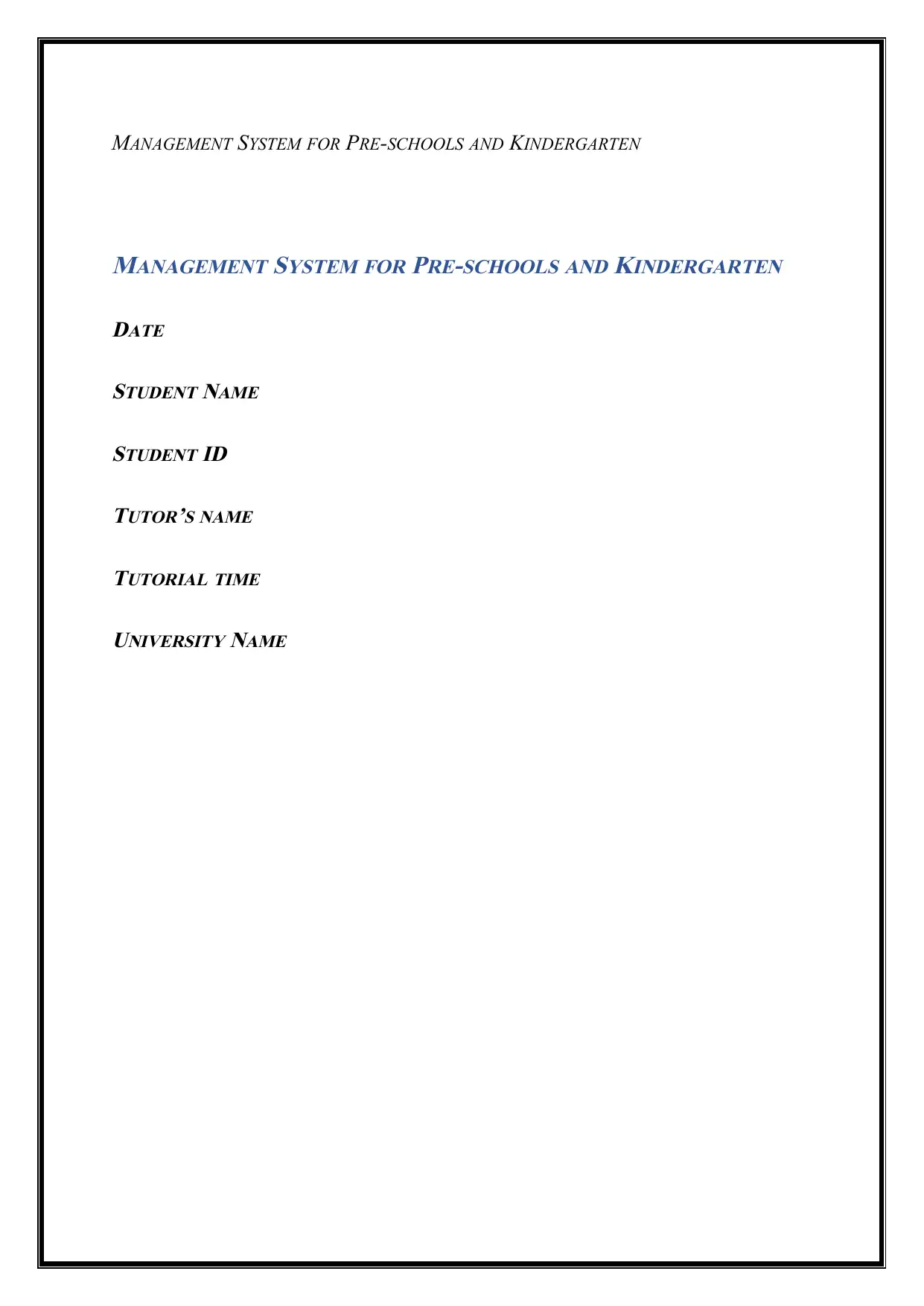
MANAGEMENT SYSTEM FOR PRE-SCHOOLS AND KINDERGARTEN
MANAGEMENT SYSTEM FOR PRE-SCHOOLS AND KINDERGARTEN
DATE
STUDENT NAME
STUDENT ID
TUTOR’S NAME
TUTORIAL TIME
UNIVERSITY NAME
MANAGEMENT SYSTEM FOR PRE-SCHOOLS AND KINDERGARTEN
DATE
STUDENT NAME
STUDENT ID
TUTOR’S NAME
TUTORIAL TIME
UNIVERSITY NAME
Secure Best Marks with AI Grader
Need help grading? Try our AI Grader for instant feedback on your assignments.
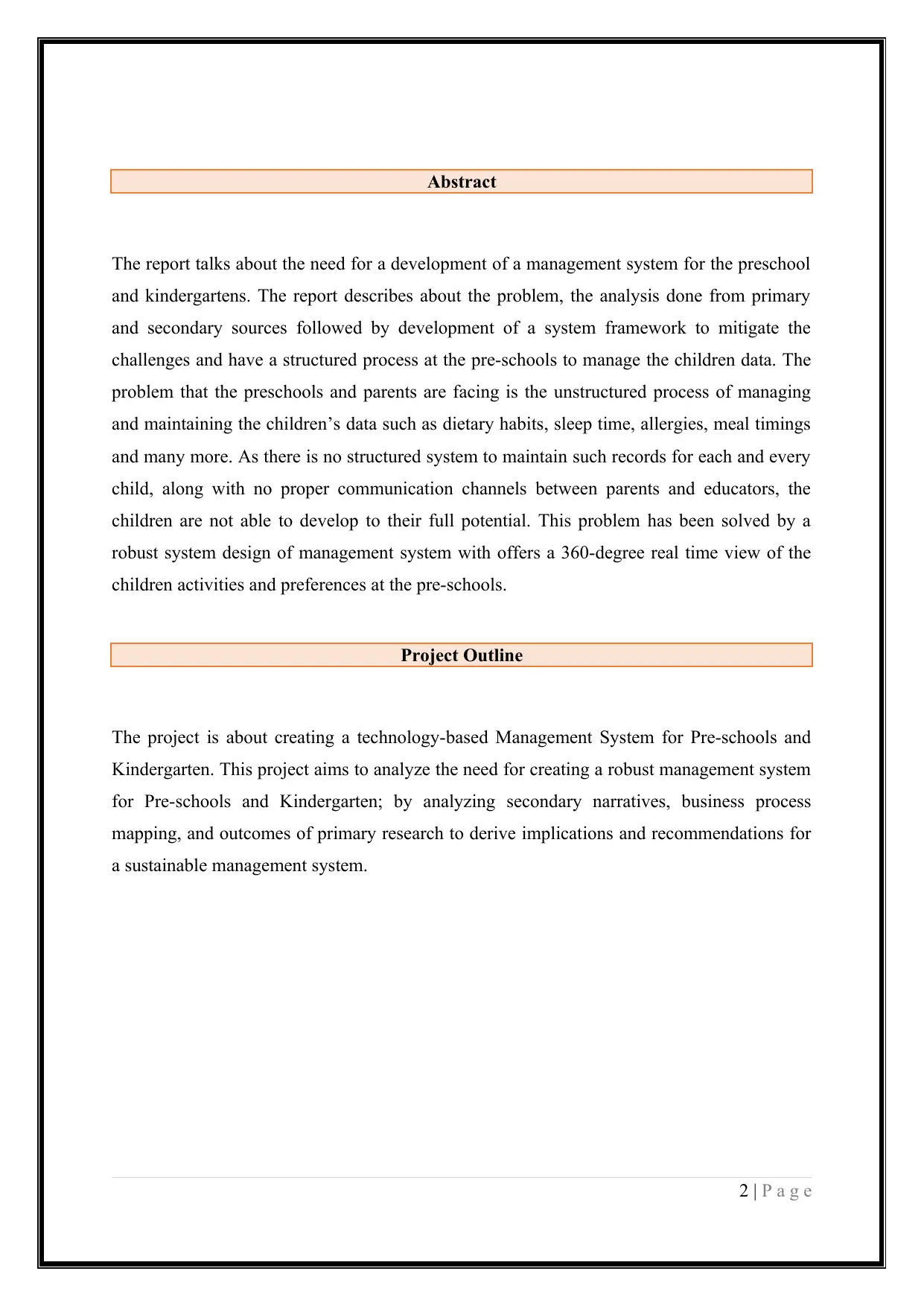
Abstract
The report talks about the need for a development of a management system for the preschool
and kindergartens. The report describes about the problem, the analysis done from primary
and secondary sources followed by development of a system framework to mitigate the
challenges and have a structured process at the pre-schools to manage the children data. The
problem that the preschools and parents are facing is the unstructured process of managing
and maintaining the children’s data such as dietary habits, sleep time, allergies, meal timings
and many more. As there is no structured system to maintain such records for each and every
child, along with no proper communication channels between parents and educators, the
children are not able to develop to their full potential. This problem has been solved by a
robust system design of management system with offers a 360-degree real time view of the
children activities and preferences at the pre-schools.
Project Outline
The project is about creating a technology-based Management System for Pre-schools and
Kindergarten. This project aims to analyze the need for creating a robust management system
for Pre-schools and Kindergarten; by analyzing secondary narratives, business process
mapping, and outcomes of primary research to derive implications and recommendations for
a sustainable management system.
2 | P a g e
The report talks about the need for a development of a management system for the preschool
and kindergartens. The report describes about the problem, the analysis done from primary
and secondary sources followed by development of a system framework to mitigate the
challenges and have a structured process at the pre-schools to manage the children data. The
problem that the preschools and parents are facing is the unstructured process of managing
and maintaining the children’s data such as dietary habits, sleep time, allergies, meal timings
and many more. As there is no structured system to maintain such records for each and every
child, along with no proper communication channels between parents and educators, the
children are not able to develop to their full potential. This problem has been solved by a
robust system design of management system with offers a 360-degree real time view of the
children activities and preferences at the pre-schools.
Project Outline
The project is about creating a technology-based Management System for Pre-schools and
Kindergarten. This project aims to analyze the need for creating a robust management system
for Pre-schools and Kindergarten; by analyzing secondary narratives, business process
mapping, and outcomes of primary research to derive implications and recommendations for
a sustainable management system.
2 | P a g e
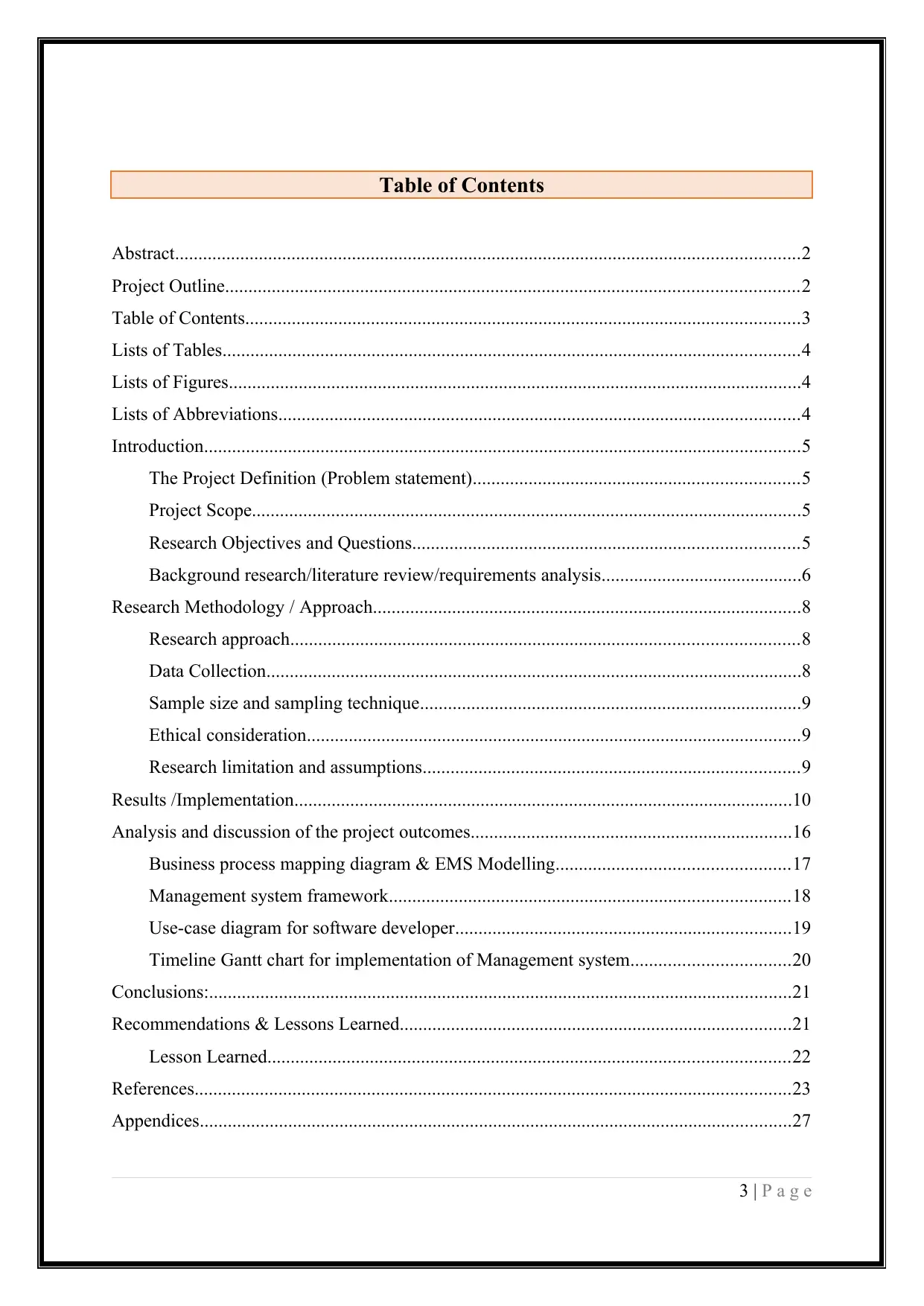
Table of Contents
Abstract......................................................................................................................................2
Project Outline...........................................................................................................................2
Table of Contents.......................................................................................................................3
Lists of Tables............................................................................................................................4
Lists of Figures...........................................................................................................................4
Lists of Abbreviations................................................................................................................4
Introduction................................................................................................................................5
The Project Definition (Problem statement)......................................................................5
Project Scope......................................................................................................................5
Research Objectives and Questions...................................................................................5
Background research/literature review/requirements analysis...........................................6
Research Methodology / Approach............................................................................................8
Research approach.............................................................................................................8
Data Collection...................................................................................................................8
Sample size and sampling technique..................................................................................9
Ethical consideration..........................................................................................................9
Research limitation and assumptions.................................................................................9
Results /Implementation...........................................................................................................10
Analysis and discussion of the project outcomes.....................................................................16
Business process mapping diagram & EMS Modelling..................................................17
Management system framework......................................................................................18
Use-case diagram for software developer........................................................................19
Timeline Gantt chart for implementation of Management system..................................20
Conclusions:.............................................................................................................................21
Recommendations & Lessons Learned....................................................................................21
Lesson Learned................................................................................................................22
References................................................................................................................................23
Appendices...............................................................................................................................27
3 | P a g e
Abstract......................................................................................................................................2
Project Outline...........................................................................................................................2
Table of Contents.......................................................................................................................3
Lists of Tables............................................................................................................................4
Lists of Figures...........................................................................................................................4
Lists of Abbreviations................................................................................................................4
Introduction................................................................................................................................5
The Project Definition (Problem statement)......................................................................5
Project Scope......................................................................................................................5
Research Objectives and Questions...................................................................................5
Background research/literature review/requirements analysis...........................................6
Research Methodology / Approach............................................................................................8
Research approach.............................................................................................................8
Data Collection...................................................................................................................8
Sample size and sampling technique..................................................................................9
Ethical consideration..........................................................................................................9
Research limitation and assumptions.................................................................................9
Results /Implementation...........................................................................................................10
Analysis and discussion of the project outcomes.....................................................................16
Business process mapping diagram & EMS Modelling..................................................17
Management system framework......................................................................................18
Use-case diagram for software developer........................................................................19
Timeline Gantt chart for implementation of Management system..................................20
Conclusions:.............................................................................................................................21
Recommendations & Lessons Learned....................................................................................21
Lesson Learned................................................................................................................22
References................................................................................................................................23
Appendices...............................................................................................................................27
3 | P a g e
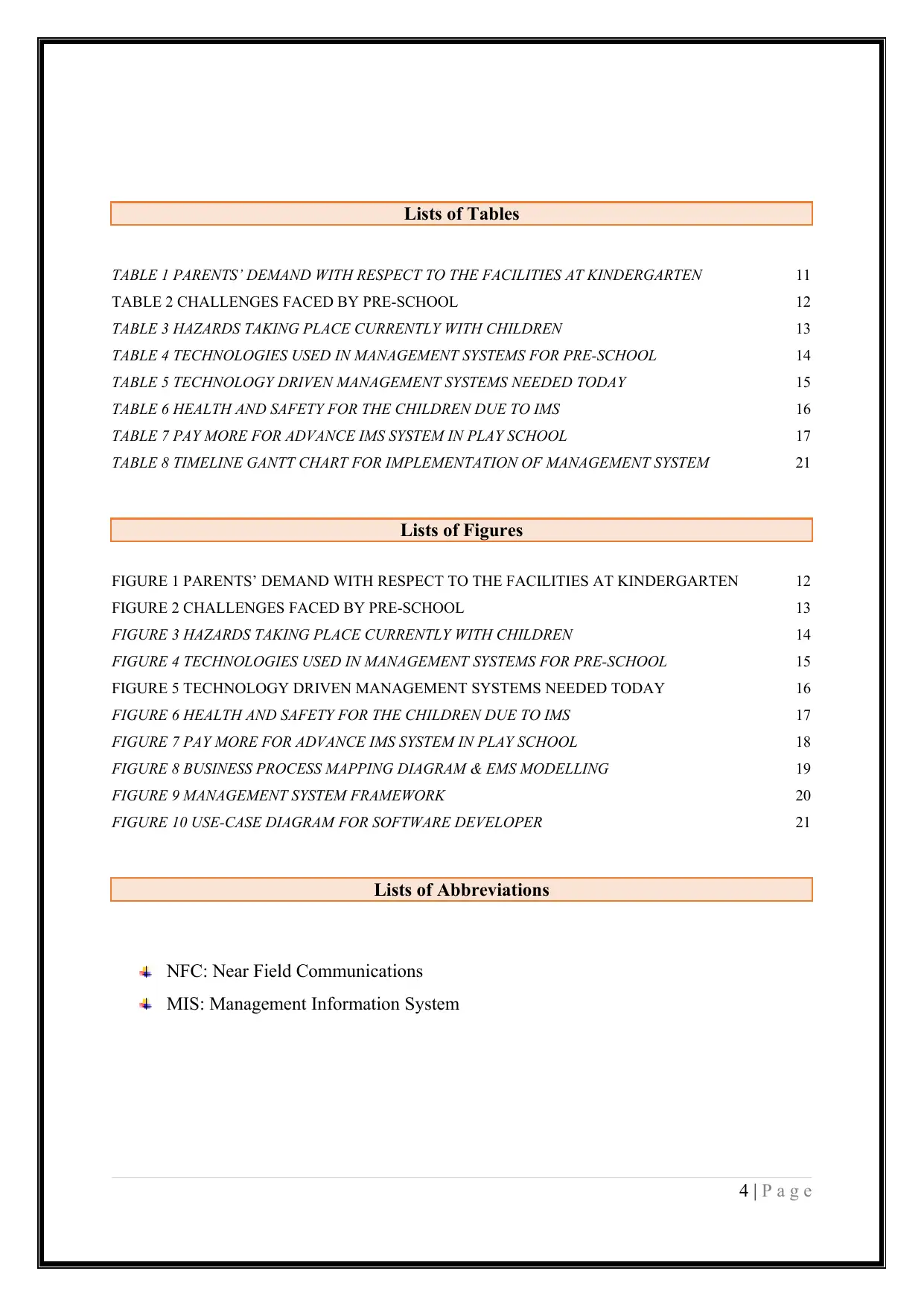
Lists of Tables
TABLE 1 PARENTS’ DEMAND WITH RESPECT TO THE FACILITIES AT KINDERGARTEN 11
TABLE 2 CHALLENGES FACED BY PRE-SCHOOL 12
TABLE 3 HAZARDS TAKING PLACE CURRENTLY WITH CHILDREN 13
TABLE 4 TECHNOLOGIES USED IN MANAGEMENT SYSTEMS FOR PRE-SCHOOL 14
TABLE 5 TECHNOLOGY DRIVEN MANAGEMENT SYSTEMS NEEDED TODAY 15
TABLE 6 HEALTH AND SAFETY FOR THE CHILDREN DUE TO IMS 16
TABLE 7 PAY MORE FOR ADVANCE IMS SYSTEM IN PLAY SCHOOL 17
TABLE 8 TIMELINE GANTT CHART FOR IMPLEMENTATION OF MANAGEMENT SYSTEM 21
Lists of Figures
FIGURE 1 PARENTS’ DEMAND WITH RESPECT TO THE FACILITIES AT KINDERGARTEN 12
FIGURE 2 CHALLENGES FACED BY PRE-SCHOOL 13
FIGURE 3 HAZARDS TAKING PLACE CURRENTLY WITH CHILDREN 14
FIGURE 4 TECHNOLOGIES USED IN MANAGEMENT SYSTEMS FOR PRE-SCHOOL 15
FIGURE 5 TECHNOLOGY DRIVEN MANAGEMENT SYSTEMS NEEDED TODAY 16
FIGURE 6 HEALTH AND SAFETY FOR THE CHILDREN DUE TO IMS 17
FIGURE 7 PAY MORE FOR ADVANCE IMS SYSTEM IN PLAY SCHOOL 18
FIGURE 8 BUSINESS PROCESS MAPPING DIAGRAM & EMS MODELLING 19
FIGURE 9 MANAGEMENT SYSTEM FRAMEWORK 20
FIGURE 10 USE-CASE DIAGRAM FOR SOFTWARE DEVELOPER 21
Lists of Abbreviations
NFC: Near Field Communications
MIS: Management Information System
4 | P a g e
TABLE 1 PARENTS’ DEMAND WITH RESPECT TO THE FACILITIES AT KINDERGARTEN 11
TABLE 2 CHALLENGES FACED BY PRE-SCHOOL 12
TABLE 3 HAZARDS TAKING PLACE CURRENTLY WITH CHILDREN 13
TABLE 4 TECHNOLOGIES USED IN MANAGEMENT SYSTEMS FOR PRE-SCHOOL 14
TABLE 5 TECHNOLOGY DRIVEN MANAGEMENT SYSTEMS NEEDED TODAY 15
TABLE 6 HEALTH AND SAFETY FOR THE CHILDREN DUE TO IMS 16
TABLE 7 PAY MORE FOR ADVANCE IMS SYSTEM IN PLAY SCHOOL 17
TABLE 8 TIMELINE GANTT CHART FOR IMPLEMENTATION OF MANAGEMENT SYSTEM 21
Lists of Figures
FIGURE 1 PARENTS’ DEMAND WITH RESPECT TO THE FACILITIES AT KINDERGARTEN 12
FIGURE 2 CHALLENGES FACED BY PRE-SCHOOL 13
FIGURE 3 HAZARDS TAKING PLACE CURRENTLY WITH CHILDREN 14
FIGURE 4 TECHNOLOGIES USED IN MANAGEMENT SYSTEMS FOR PRE-SCHOOL 15
FIGURE 5 TECHNOLOGY DRIVEN MANAGEMENT SYSTEMS NEEDED TODAY 16
FIGURE 6 HEALTH AND SAFETY FOR THE CHILDREN DUE TO IMS 17
FIGURE 7 PAY MORE FOR ADVANCE IMS SYSTEM IN PLAY SCHOOL 18
FIGURE 8 BUSINESS PROCESS MAPPING DIAGRAM & EMS MODELLING 19
FIGURE 9 MANAGEMENT SYSTEM FRAMEWORK 20
FIGURE 10 USE-CASE DIAGRAM FOR SOFTWARE DEVELOPER 21
Lists of Abbreviations
NFC: Near Field Communications
MIS: Management Information System
4 | P a g e
Secure Best Marks with AI Grader
Need help grading? Try our AI Grader for instant feedback on your assignments.
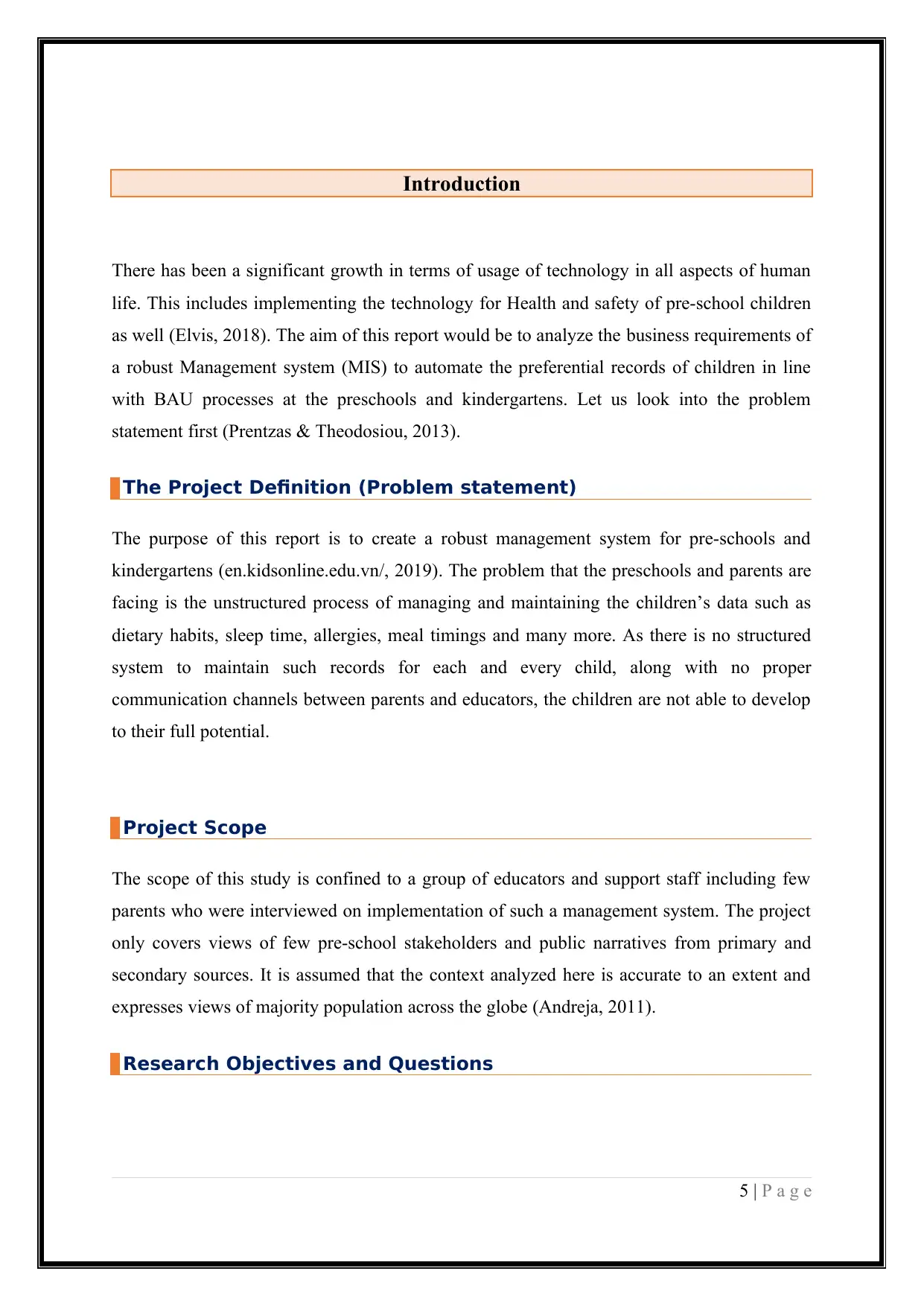
Introduction
There has been a significant growth in terms of usage of technology in all aspects of human
life. This includes implementing the technology for Health and safety of pre-school children
as well (Elvis, 2018). The aim of this report would be to analyze the business requirements of
a robust Management system (MIS) to automate the preferential records of children in line
with BAU processes at the preschools and kindergartens. Let us look into the problem
statement first (Prentzas & Theodosiou, 2013).
The Project Definition (Problem statement)
The purpose of this report is to create a robust management system for pre-schools and
kindergartens (en.kidsonline.edu.vn/, 2019). The problem that the preschools and parents are
facing is the unstructured process of managing and maintaining the children’s data such as
dietary habits, sleep time, allergies, meal timings and many more. As there is no structured
system to maintain such records for each and every child, along with no proper
communication channels between parents and educators, the children are not able to develop
to their full potential.
Project Scope
The scope of this study is confined to a group of educators and support staff including few
parents who were interviewed on implementation of such a management system. The project
only covers views of few pre-school stakeholders and public narratives from primary and
secondary sources. It is assumed that the context analyzed here is accurate to an extent and
expresses views of majority population across the globe (Andreja, 2011).
Research Objectives and Questions
5 | P a g e
There has been a significant growth in terms of usage of technology in all aspects of human
life. This includes implementing the technology for Health and safety of pre-school children
as well (Elvis, 2018). The aim of this report would be to analyze the business requirements of
a robust Management system (MIS) to automate the preferential records of children in line
with BAU processes at the preschools and kindergartens. Let us look into the problem
statement first (Prentzas & Theodosiou, 2013).
The Project Definition (Problem statement)
The purpose of this report is to create a robust management system for pre-schools and
kindergartens (en.kidsonline.edu.vn/, 2019). The problem that the preschools and parents are
facing is the unstructured process of managing and maintaining the children’s data such as
dietary habits, sleep time, allergies, meal timings and many more. As there is no structured
system to maintain such records for each and every child, along with no proper
communication channels between parents and educators, the children are not able to develop
to their full potential.
Project Scope
The scope of this study is confined to a group of educators and support staff including few
parents who were interviewed on implementation of such a management system. The project
only covers views of few pre-school stakeholders and public narratives from primary and
secondary sources. It is assumed that the context analyzed here is accurate to an extent and
expresses views of majority population across the globe (Andreja, 2011).
Research Objectives and Questions
5 | P a g e
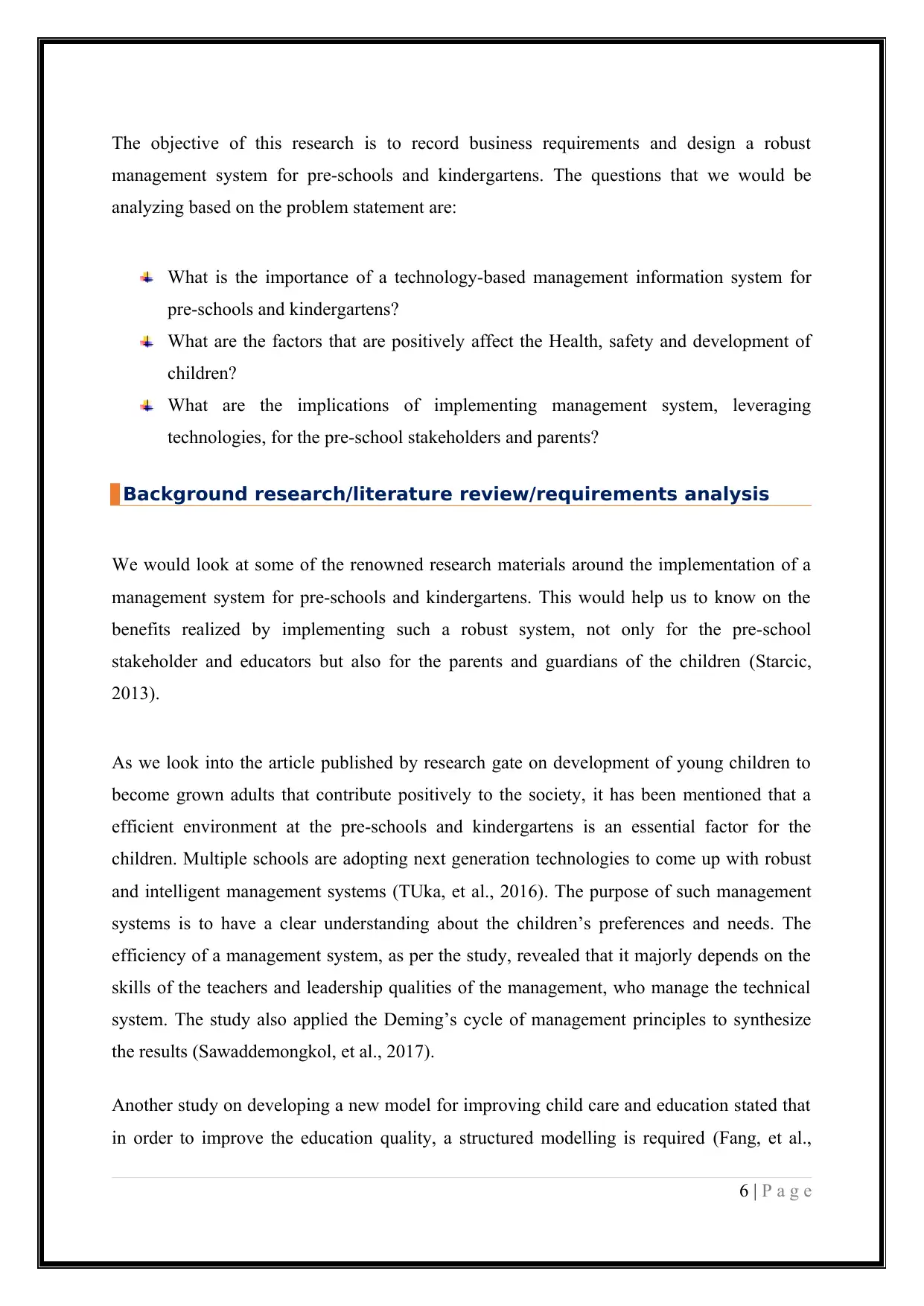
The objective of this research is to record business requirements and design a robust
management system for pre-schools and kindergartens. The questions that we would be
analyzing based on the problem statement are:
What is the importance of a technology-based management information system for
pre-schools and kindergartens?
What are the factors that are positively affect the Health, safety and development of
children?
What are the implications of implementing management system, leveraging
technologies, for the pre-school stakeholders and parents?
Background research/literature review/requirements analysis
We would look at some of the renowned research materials around the implementation of a
management system for pre-schools and kindergartens. This would help us to know on the
benefits realized by implementing such a robust system, not only for the pre-school
stakeholder and educators but also for the parents and guardians of the children (Starcic,
2013).
As we look into the article published by research gate on development of young children to
become grown adults that contribute positively to the society, it has been mentioned that a
efficient environment at the pre-schools and kindergartens is an essential factor for the
children. Multiple schools are adopting next generation technologies to come up with robust
and intelligent management systems (TUka, et al., 2016). The purpose of such management
systems is to have a clear understanding about the children’s preferences and needs. The
efficiency of a management system, as per the study, revealed that it majorly depends on the
skills of the teachers and leadership qualities of the management, who manage the technical
system. The study also applied the Deming’s cycle of management principles to synthesize
the results (Sawaddemongkol, et al., 2017).
Another study on developing a new model for improving child care and education stated that
in order to improve the education quality, a structured modelling is required (Fang, et al.,
6 | P a g e
management system for pre-schools and kindergartens. The questions that we would be
analyzing based on the problem statement are:
What is the importance of a technology-based management information system for
pre-schools and kindergartens?
What are the factors that are positively affect the Health, safety and development of
children?
What are the implications of implementing management system, leveraging
technologies, for the pre-school stakeholders and parents?
Background research/literature review/requirements analysis
We would look at some of the renowned research materials around the implementation of a
management system for pre-schools and kindergartens. This would help us to know on the
benefits realized by implementing such a robust system, not only for the pre-school
stakeholder and educators but also for the parents and guardians of the children (Starcic,
2013).
As we look into the article published by research gate on development of young children to
become grown adults that contribute positively to the society, it has been mentioned that a
efficient environment at the pre-schools and kindergartens is an essential factor for the
children. Multiple schools are adopting next generation technologies to come up with robust
and intelligent management systems (TUka, et al., 2016). The purpose of such management
systems is to have a clear understanding about the children’s preferences and needs. The
efficiency of a management system, as per the study, revealed that it majorly depends on the
skills of the teachers and leadership qualities of the management, who manage the technical
system. The study also applied the Deming’s cycle of management principles to synthesize
the results (Sawaddemongkol, et al., 2017).
Another study on developing a new model for improving child care and education stated that
in order to improve the education quality, a structured modelling is required (Fang, et al.,
6 | P a g e
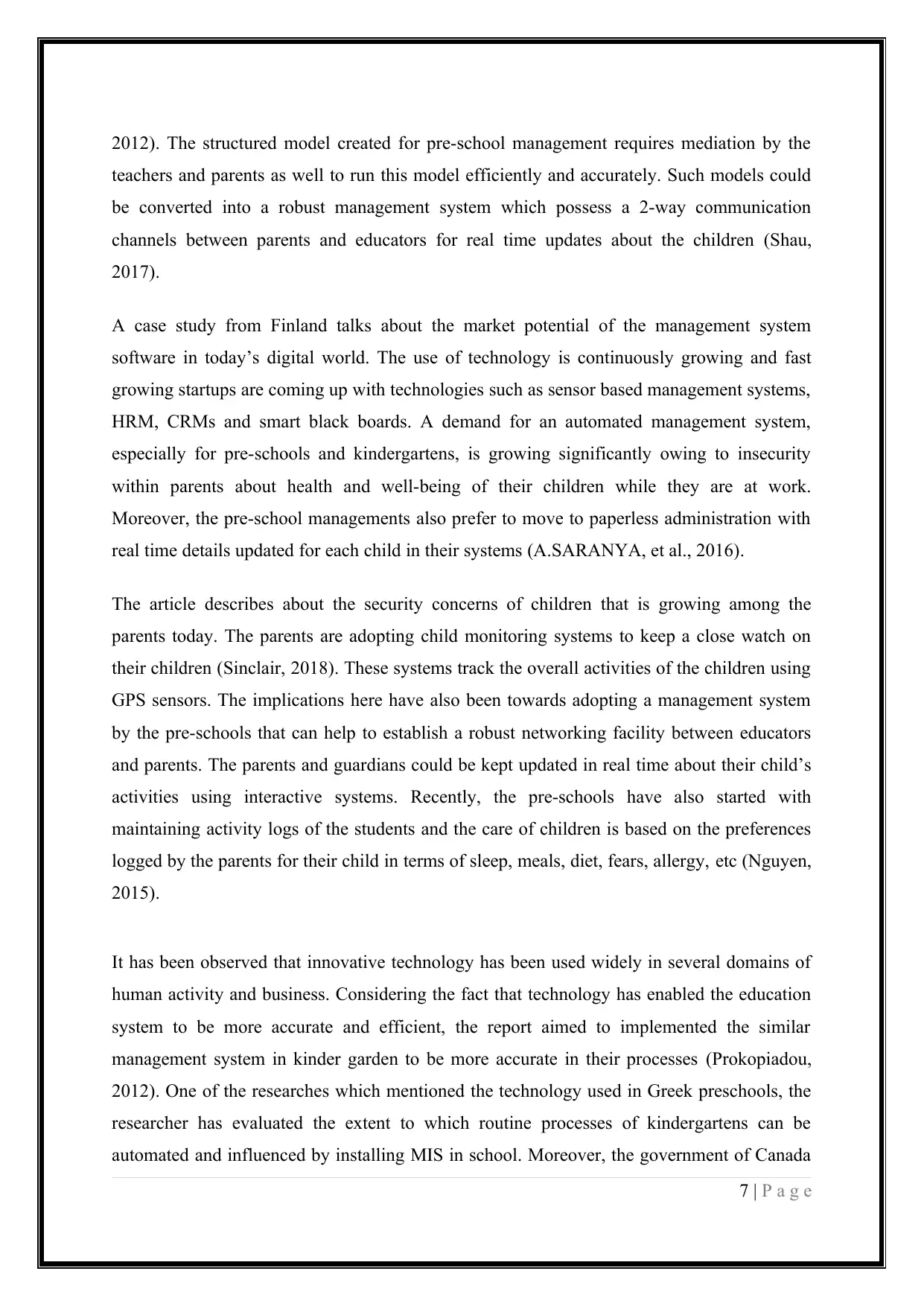
2012). The structured model created for pre-school management requires mediation by the
teachers and parents as well to run this model efficiently and accurately. Such models could
be converted into a robust management system which possess a 2-way communication
channels between parents and educators for real time updates about the children (Shau,
2017).
A case study from Finland talks about the market potential of the management system
software in today’s digital world. The use of technology is continuously growing and fast
growing startups are coming up with technologies such as sensor based management systems,
HRM, CRMs and smart black boards. A demand for an automated management system,
especially for pre-schools and kindergartens, is growing significantly owing to insecurity
within parents about health and well-being of their children while they are at work.
Moreover, the pre-school managements also prefer to move to paperless administration with
real time details updated for each child in their systems (A.SARANYA, et al., 2016).
The article describes about the security concerns of children that is growing among the
parents today. The parents are adopting child monitoring systems to keep a close watch on
their children (Sinclair, 2018). These systems track the overall activities of the children using
GPS sensors. The implications here have also been towards adopting a management system
by the pre-schools that can help to establish a robust networking facility between educators
and parents. The parents and guardians could be kept updated in real time about their child’s
activities using interactive systems. Recently, the pre-schools have also started with
maintaining activity logs of the students and the care of children is based on the preferences
logged by the parents for their child in terms of sleep, meals, diet, fears, allergy, etc (Nguyen,
2015).
It has been observed that innovative technology has been used widely in several domains of
human activity and business. Considering the fact that technology has enabled the education
system to be more accurate and efficient, the report aimed to implemented the similar
management system in kinder garden to be more accurate in their processes (Prokopiadou,
2012). One of the researches which mentioned the technology used in Greek preschools, the
researcher has evaluated the extent to which routine processes of kindergartens can be
automated and influenced by installing MIS in school. Moreover, the government of Canada
7 | P a g e
teachers and parents as well to run this model efficiently and accurately. Such models could
be converted into a robust management system which possess a 2-way communication
channels between parents and educators for real time updates about the children (Shau,
2017).
A case study from Finland talks about the market potential of the management system
software in today’s digital world. The use of technology is continuously growing and fast
growing startups are coming up with technologies such as sensor based management systems,
HRM, CRMs and smart black boards. A demand for an automated management system,
especially for pre-schools and kindergartens, is growing significantly owing to insecurity
within parents about health and well-being of their children while they are at work.
Moreover, the pre-school managements also prefer to move to paperless administration with
real time details updated for each child in their systems (A.SARANYA, et al., 2016).
The article describes about the security concerns of children that is growing among the
parents today. The parents are adopting child monitoring systems to keep a close watch on
their children (Sinclair, 2018). These systems track the overall activities of the children using
GPS sensors. The implications here have also been towards adopting a management system
by the pre-schools that can help to establish a robust networking facility between educators
and parents. The parents and guardians could be kept updated in real time about their child’s
activities using interactive systems. Recently, the pre-schools have also started with
maintaining activity logs of the students and the care of children is based on the preferences
logged by the parents for their child in terms of sleep, meals, diet, fears, allergy, etc (Nguyen,
2015).
It has been observed that innovative technology has been used widely in several domains of
human activity and business. Considering the fact that technology has enabled the education
system to be more accurate and efficient, the report aimed to implemented the similar
management system in kinder garden to be more accurate in their processes (Prokopiadou,
2012). One of the researches which mentioned the technology used in Greek preschools, the
researcher has evaluated the extent to which routine processes of kindergartens can be
automated and influenced by installing MIS in school. Moreover, the government of Canada
7 | P a g e
Paraphrase This Document
Need a fresh take? Get an instant paraphrase of this document with our AI Paraphraser
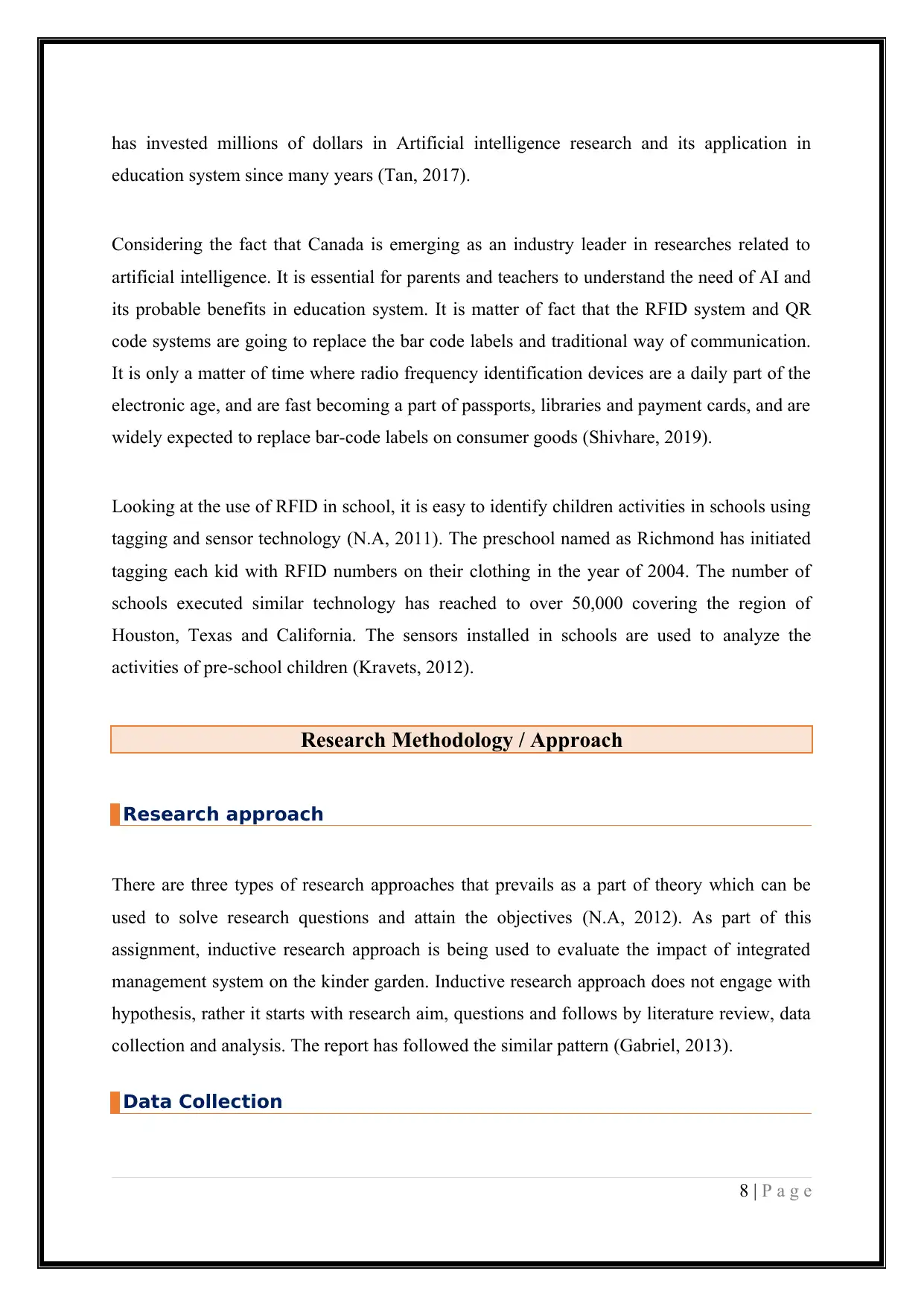
has invested millions of dollars in Artificial intelligence research and its application in
education system since many years (Tan, 2017).
Considering the fact that Canada is emerging as an industry leader in researches related to
artificial intelligence. It is essential for parents and teachers to understand the need of AI and
its probable benefits in education system. It is matter of fact that the RFID system and QR
code systems are going to replace the bar code labels and traditional way of communication.
It is only a matter of time where radio frequency identification devices are a daily part of the
electronic age, and are fast becoming a part of passports, libraries and payment cards, and are
widely expected to replace bar-code labels on consumer goods (Shivhare, 2019).
Looking at the use of RFID in school, it is easy to identify children activities in schools using
tagging and sensor technology (N.A, 2011). The preschool named as Richmond has initiated
tagging each kid with RFID numbers on their clothing in the year of 2004. The number of
schools executed similar technology has reached to over 50,000 covering the region of
Houston, Texas and California. The sensors installed in schools are used to analyze the
activities of pre-school children (Kravets, 2012).
Research Methodology / Approach
Research approach
There are three types of research approaches that prevails as a part of theory which can be
used to solve research questions and attain the objectives (N.A, 2012). As part of this
assignment, inductive research approach is being used to evaluate the impact of integrated
management system on the kinder garden. Inductive research approach does not engage with
hypothesis, rather it starts with research aim, questions and follows by literature review, data
collection and analysis. The report has followed the similar pattern (Gabriel, 2013).
Data Collection
8 | P a g e
education system since many years (Tan, 2017).
Considering the fact that Canada is emerging as an industry leader in researches related to
artificial intelligence. It is essential for parents and teachers to understand the need of AI and
its probable benefits in education system. It is matter of fact that the RFID system and QR
code systems are going to replace the bar code labels and traditional way of communication.
It is only a matter of time where radio frequency identification devices are a daily part of the
electronic age, and are fast becoming a part of passports, libraries and payment cards, and are
widely expected to replace bar-code labels on consumer goods (Shivhare, 2019).
Looking at the use of RFID in school, it is easy to identify children activities in schools using
tagging and sensor technology (N.A, 2011). The preschool named as Richmond has initiated
tagging each kid with RFID numbers on their clothing in the year of 2004. The number of
schools executed similar technology has reached to over 50,000 covering the region of
Houston, Texas and California. The sensors installed in schools are used to analyze the
activities of pre-school children (Kravets, 2012).
Research Methodology / Approach
Research approach
There are three types of research approaches that prevails as a part of theory which can be
used to solve research questions and attain the objectives (N.A, 2012). As part of this
assignment, inductive research approach is being used to evaluate the impact of integrated
management system on the kinder garden. Inductive research approach does not engage with
hypothesis, rather it starts with research aim, questions and follows by literature review, data
collection and analysis. The report has followed the similar pattern (Gabriel, 2013).
Data Collection
8 | P a g e
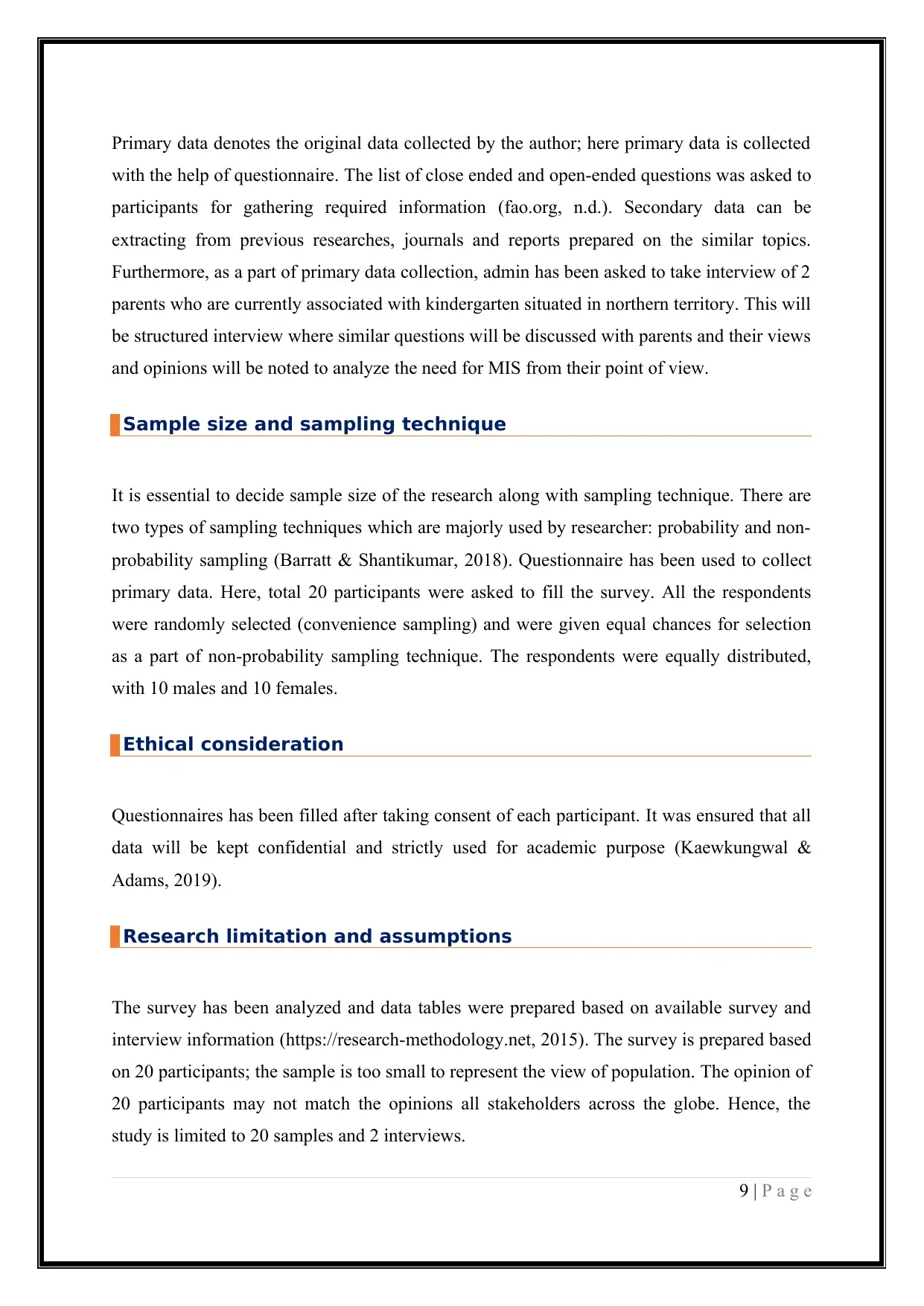
Primary data denotes the original data collected by the author; here primary data is collected
with the help of questionnaire. The list of close ended and open-ended questions was asked to
participants for gathering required information (fao.org, n.d.). Secondary data can be
extracting from previous researches, journals and reports prepared on the similar topics.
Furthermore, as a part of primary data collection, admin has been asked to take interview of 2
parents who are currently associated with kindergarten situated in northern territory. This will
be structured interview where similar questions will be discussed with parents and their views
and opinions will be noted to analyze the need for MIS from their point of view.
Sample size and sampling technique
It is essential to decide sample size of the research along with sampling technique. There are
two types of sampling techniques which are majorly used by researcher: probability and non-
probability sampling (Barratt & Shantikumar, 2018). Questionnaire has been used to collect
primary data. Here, total 20 participants were asked to fill the survey. All the respondents
were randomly selected (convenience sampling) and were given equal chances for selection
as a part of non-probability sampling technique. The respondents were equally distributed,
with 10 males and 10 females.
Ethical consideration
Questionnaires has been filled after taking consent of each participant. It was ensured that all
data will be kept confidential and strictly used for academic purpose (Kaewkungwal &
Adams, 2019).
Research limitation and assumptions
The survey has been analyzed and data tables were prepared based on available survey and
interview information (https://research-methodology.net, 2015). The survey is prepared based
on 20 participants; the sample is too small to represent the view of population. The opinion of
20 participants may not match the opinions all stakeholders across the globe. Hence, the
study is limited to 20 samples and 2 interviews.
9 | P a g e
with the help of questionnaire. The list of close ended and open-ended questions was asked to
participants for gathering required information (fao.org, n.d.). Secondary data can be
extracting from previous researches, journals and reports prepared on the similar topics.
Furthermore, as a part of primary data collection, admin has been asked to take interview of 2
parents who are currently associated with kindergarten situated in northern territory. This will
be structured interview where similar questions will be discussed with parents and their views
and opinions will be noted to analyze the need for MIS from their point of view.
Sample size and sampling technique
It is essential to decide sample size of the research along with sampling technique. There are
two types of sampling techniques which are majorly used by researcher: probability and non-
probability sampling (Barratt & Shantikumar, 2018). Questionnaire has been used to collect
primary data. Here, total 20 participants were asked to fill the survey. All the respondents
were randomly selected (convenience sampling) and were given equal chances for selection
as a part of non-probability sampling technique. The respondents were equally distributed,
with 10 males and 10 females.
Ethical consideration
Questionnaires has been filled after taking consent of each participant. It was ensured that all
data will be kept confidential and strictly used for academic purpose (Kaewkungwal &
Adams, 2019).
Research limitation and assumptions
The survey has been analyzed and data tables were prepared based on available survey and
interview information (https://research-methodology.net, 2015). The survey is prepared based
on 20 participants; the sample is too small to represent the view of population. The opinion of
20 participants may not match the opinions all stakeholders across the globe. Hence, the
study is limited to 20 samples and 2 interviews.
9 | P a g e
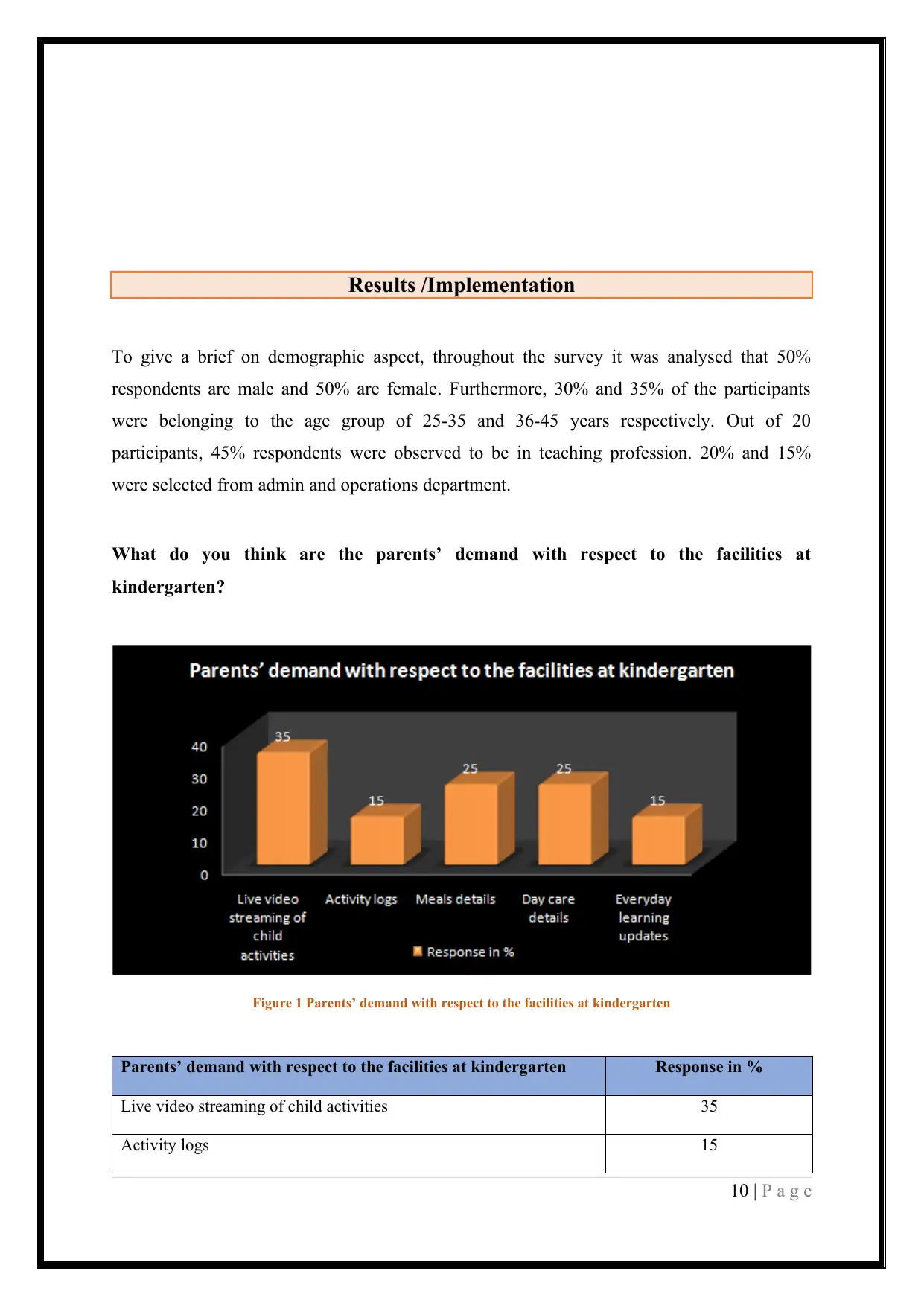
Results /Implementation
To give a brief on demographic aspect, throughout the survey it was analysed that 50%
respondents are male and 50% are female. Furthermore, 30% and 35% of the participants
were belonging to the age group of 25-35 and 36-45 years respectively. Out of 20
participants, 45% respondents were observed to be in teaching profession. 20% and 15%
were selected from admin and operations department.
What do you think are the parents’ demand with respect to the facilities at
kindergarten?
Figure 1 Parents’ demand with respect to the facilities at kindergarten
Parents’ demand with respect to the facilities at kindergarten Response in %
Live video streaming of child activities 35
Activity logs 15
10 | P a g e
To give a brief on demographic aspect, throughout the survey it was analysed that 50%
respondents are male and 50% are female. Furthermore, 30% and 35% of the participants
were belonging to the age group of 25-35 and 36-45 years respectively. Out of 20
participants, 45% respondents were observed to be in teaching profession. 20% and 15%
were selected from admin and operations department.
What do you think are the parents’ demand with respect to the facilities at
kindergarten?
Figure 1 Parents’ demand with respect to the facilities at kindergarten
Parents’ demand with respect to the facilities at kindergarten Response in %
Live video streaming of child activities 35
Activity logs 15
10 | P a g e
Secure Best Marks with AI Grader
Need help grading? Try our AI Grader for instant feedback on your assignments.
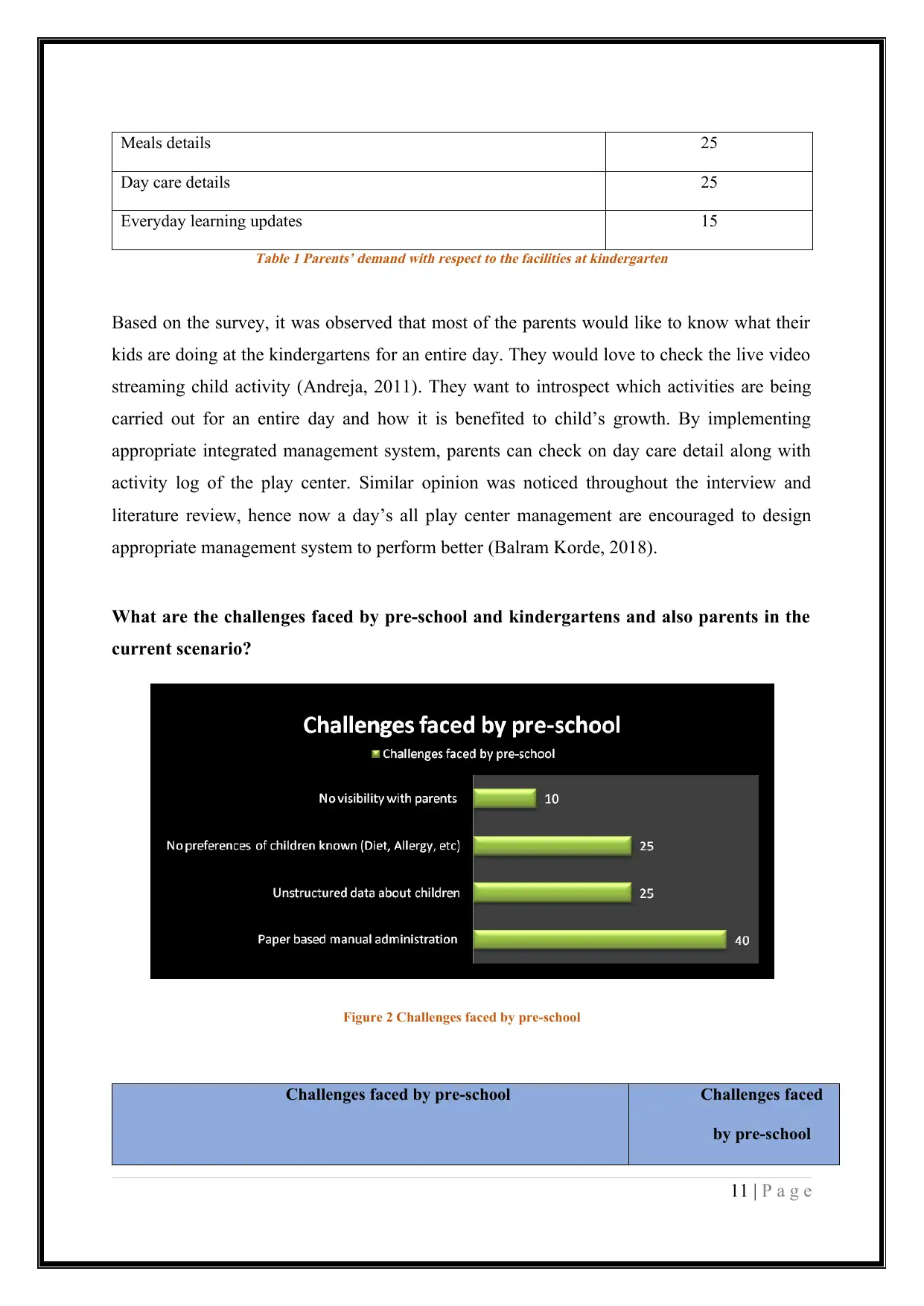
Meals details 25
Day care details 25
Everyday learning updates 15
Table 1 Parents’ demand with respect to the facilities at kindergarten
Based on the survey, it was observed that most of the parents would like to know what their
kids are doing at the kindergartens for an entire day. They would love to check the live video
streaming child activity (Andreja, 2011). They want to introspect which activities are being
carried out for an entire day and how it is benefited to child’s growth. By implementing
appropriate integrated management system, parents can check on day care detail along with
activity log of the play center. Similar opinion was noticed throughout the interview and
literature review, hence now a day’s all play center management are encouraged to design
appropriate management system to perform better (Balram Korde, 2018).
What are the challenges faced by pre-school and kindergartens and also parents in the
current scenario?
Figure 2 Challenges faced by pre-school
Challenges faced by pre-school Challenges faced
by pre-school
11 | P a g e
Day care details 25
Everyday learning updates 15
Table 1 Parents’ demand with respect to the facilities at kindergarten
Based on the survey, it was observed that most of the parents would like to know what their
kids are doing at the kindergartens for an entire day. They would love to check the live video
streaming child activity (Andreja, 2011). They want to introspect which activities are being
carried out for an entire day and how it is benefited to child’s growth. By implementing
appropriate integrated management system, parents can check on day care detail along with
activity log of the play center. Similar opinion was noticed throughout the interview and
literature review, hence now a day’s all play center management are encouraged to design
appropriate management system to perform better (Balram Korde, 2018).
What are the challenges faced by pre-school and kindergartens and also parents in the
current scenario?
Figure 2 Challenges faced by pre-school
Challenges faced by pre-school Challenges faced
by pre-school
11 | P a g e
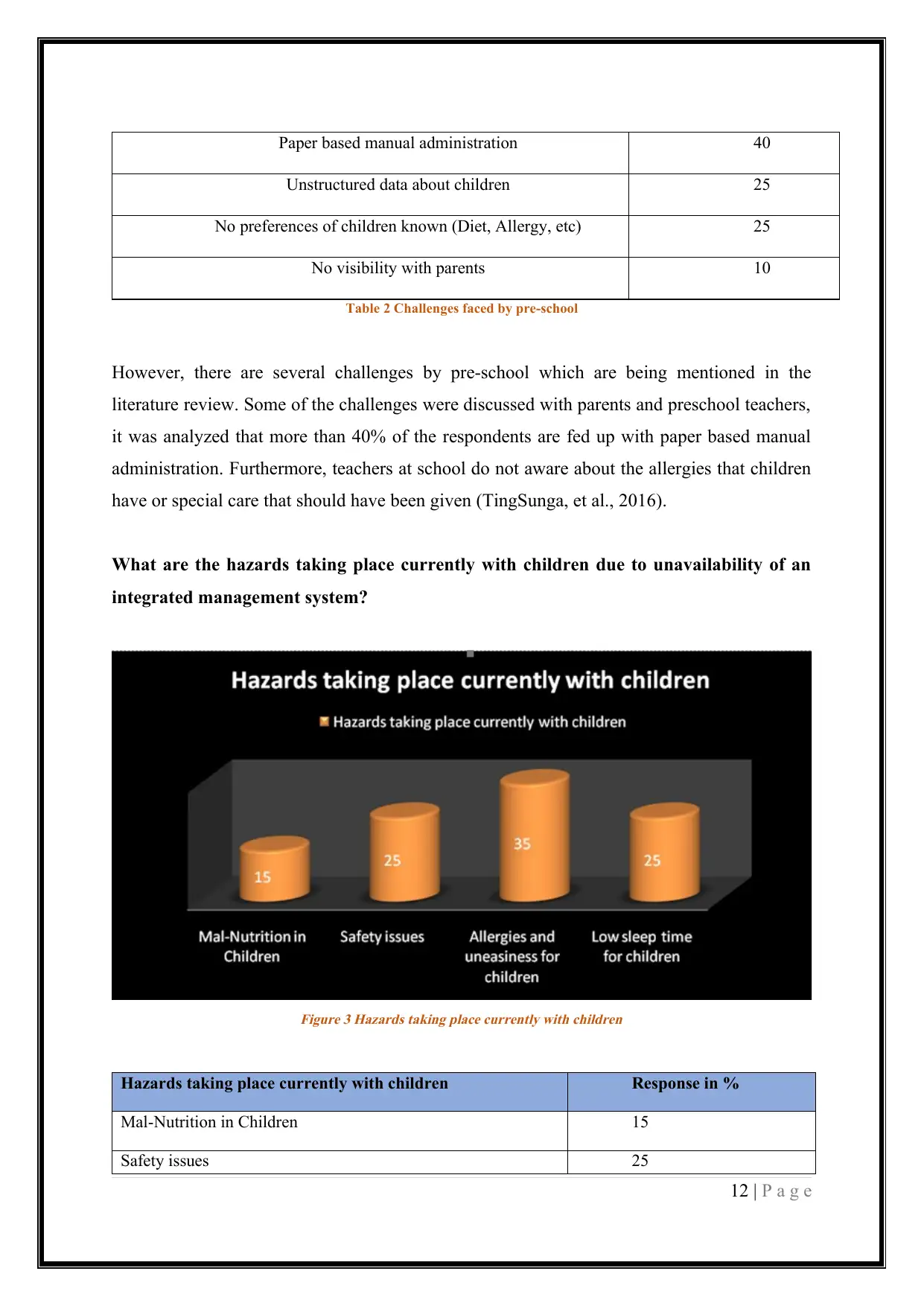
Paper based manual administration 40
Unstructured data about children 25
No preferences of children known (Diet, Allergy, etc) 25
No visibility with parents 10
Table 2 Challenges faced by pre-school
However, there are several challenges by pre-school which are being mentioned in the
literature review. Some of the challenges were discussed with parents and preschool teachers,
it was analyzed that more than 40% of the respondents are fed up with paper based manual
administration. Furthermore, teachers at school do not aware about the allergies that children
have or special care that should have been given (TingSunga, et al., 2016).
What are the hazards taking place currently with children due to unavailability of an
integrated management system?
Figure 3 Hazards taking place currently with children
Hazards taking place currently with children Response in %
Mal-Nutrition in Children 15
Safety issues 25
12 | P a g e
Unstructured data about children 25
No preferences of children known (Diet, Allergy, etc) 25
No visibility with parents 10
Table 2 Challenges faced by pre-school
However, there are several challenges by pre-school which are being mentioned in the
literature review. Some of the challenges were discussed with parents and preschool teachers,
it was analyzed that more than 40% of the respondents are fed up with paper based manual
administration. Furthermore, teachers at school do not aware about the allergies that children
have or special care that should have been given (TingSunga, et al., 2016).
What are the hazards taking place currently with children due to unavailability of an
integrated management system?
Figure 3 Hazards taking place currently with children
Hazards taking place currently with children Response in %
Mal-Nutrition in Children 15
Safety issues 25
12 | P a g e
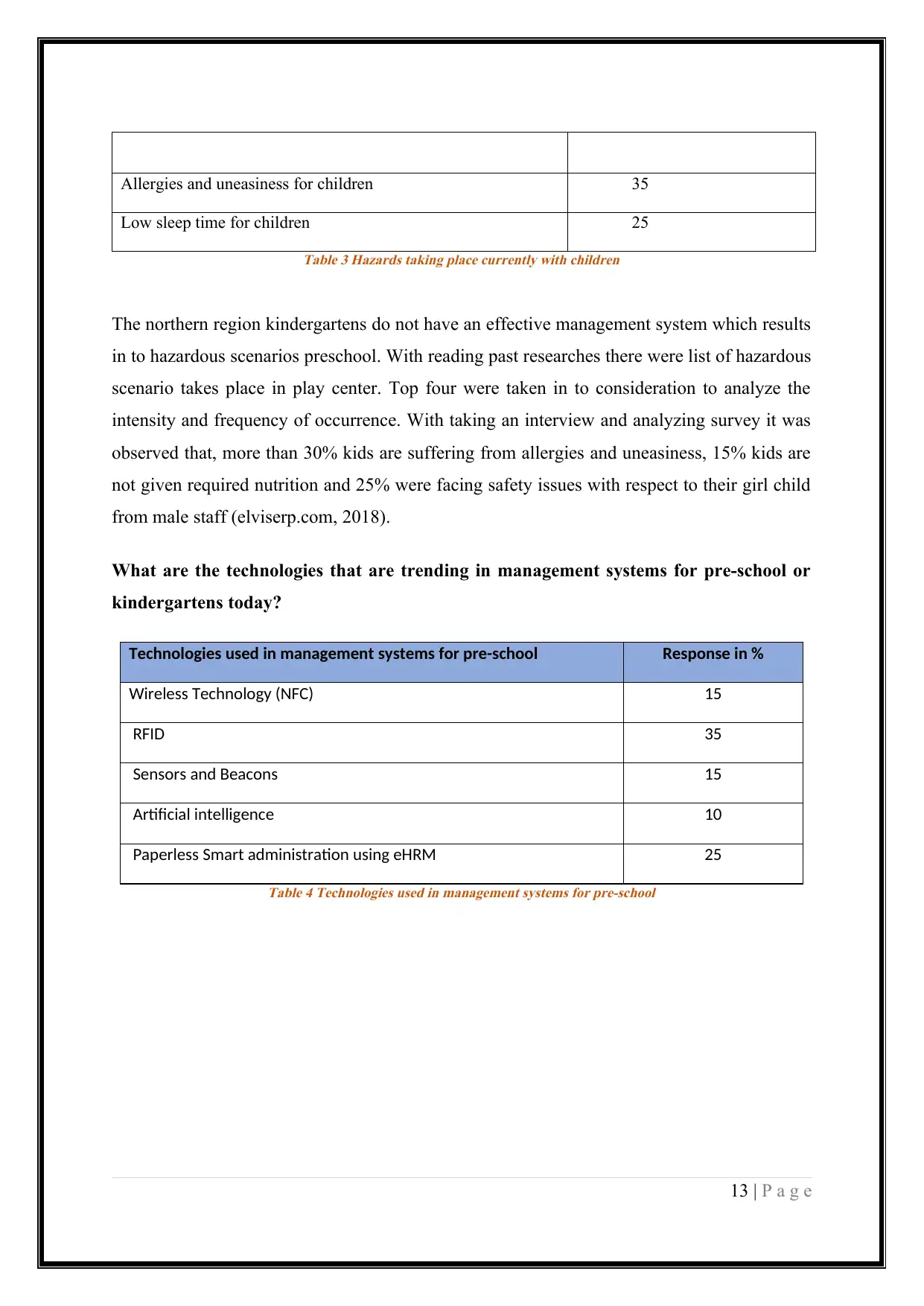
Allergies and uneasiness for children 35
Low sleep time for children 25
Table 3 Hazards taking place currently with children
The northern region kindergartens do not have an effective management system which results
in to hazardous scenarios preschool. With reading past researches there were list of hazardous
scenario takes place in play center. Top four were taken in to consideration to analyze the
intensity and frequency of occurrence. With taking an interview and analyzing survey it was
observed that, more than 30% kids are suffering from allergies and uneasiness, 15% kids are
not given required nutrition and 25% were facing safety issues with respect to their girl child
from male staff (elviserp.com, 2018).
What are the technologies that are trending in management systems for pre-school or
kindergartens today?
Technologies used in management systems for pre-school Response in %
Wireless Technology (NFC) 15
RFID 35
Sensors and Beacons 15
Artificial intelligence 10
Paperless Smart administration using eHRM 25
Table 4 Technologies used in management systems for pre-school
13 | P a g e
Low sleep time for children 25
Table 3 Hazards taking place currently with children
The northern region kindergartens do not have an effective management system which results
in to hazardous scenarios preschool. With reading past researches there were list of hazardous
scenario takes place in play center. Top four were taken in to consideration to analyze the
intensity and frequency of occurrence. With taking an interview and analyzing survey it was
observed that, more than 30% kids are suffering from allergies and uneasiness, 15% kids are
not given required nutrition and 25% were facing safety issues with respect to their girl child
from male staff (elviserp.com, 2018).
What are the technologies that are trending in management systems for pre-school or
kindergartens today?
Technologies used in management systems for pre-school Response in %
Wireless Technology (NFC) 15
RFID 35
Sensors and Beacons 15
Artificial intelligence 10
Paperless Smart administration using eHRM 25
Table 4 Technologies used in management systems for pre-school
13 | P a g e
Paraphrase This Document
Need a fresh take? Get an instant paraphrase of this document with our AI Paraphraser
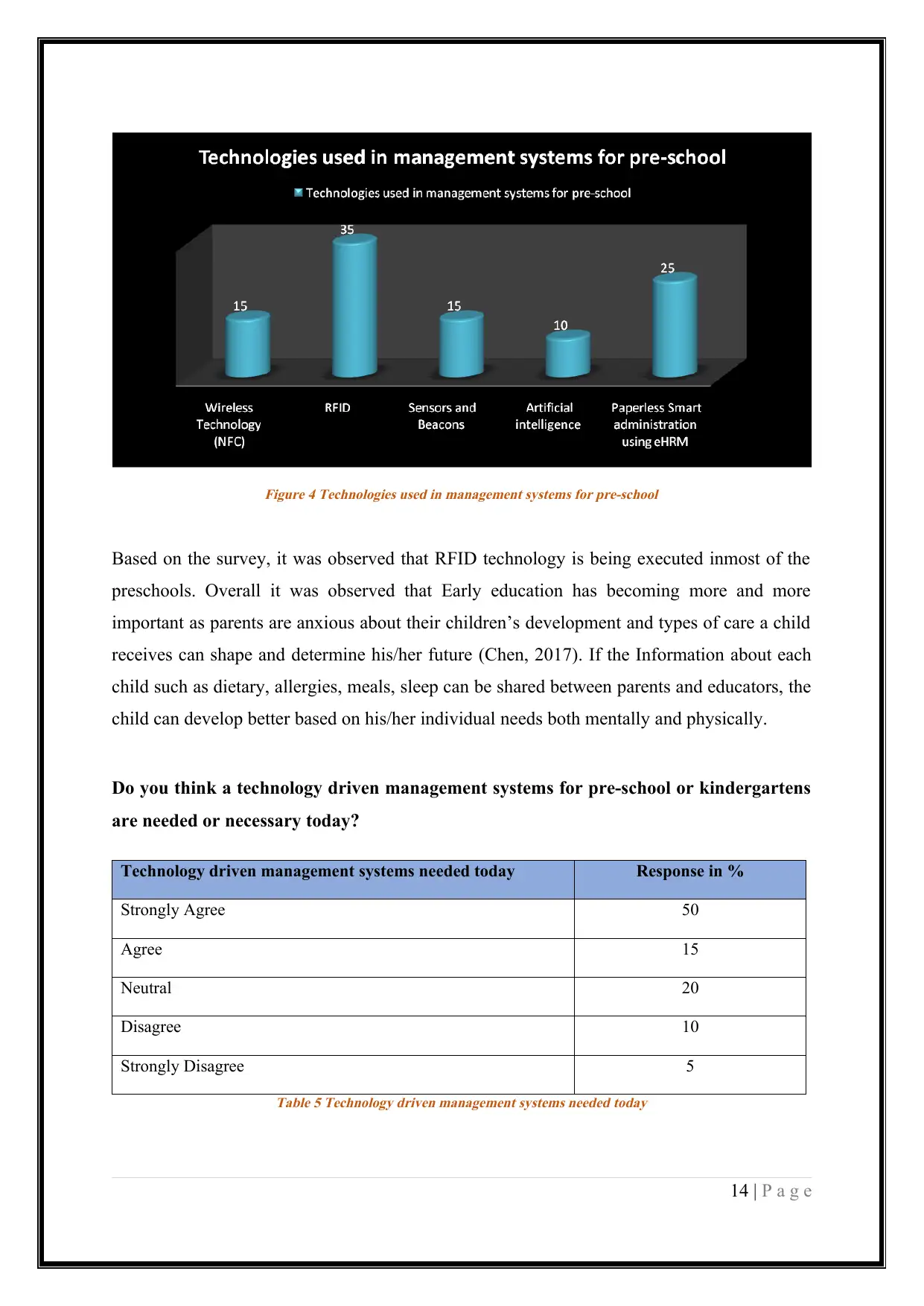
Figure 4 Technologies used in management systems for pre-school
Based on the survey, it was observed that RFID technology is being executed inmost of the
preschools. Overall it was observed that Early education has becoming more and more
important as parents are anxious about their children’s development and types of care a child
receives can shape and determine his/her future (Chen, 2017). If the Information about each
child such as dietary, allergies, meals, sleep can be shared between parents and educators, the
child can develop better based on his/her individual needs both mentally and physically.
Do you think a technology driven management systems for pre-school or kindergartens
are needed or necessary today?
Technology driven management systems needed today Response in %
Strongly Agree 50
Agree 15
Neutral 20
Disagree 10
Strongly Disagree 5
Table 5 Technology driven management systems needed today
14 | P a g e
Based on the survey, it was observed that RFID technology is being executed inmost of the
preschools. Overall it was observed that Early education has becoming more and more
important as parents are anxious about their children’s development and types of care a child
receives can shape and determine his/her future (Chen, 2017). If the Information about each
child such as dietary, allergies, meals, sleep can be shared between parents and educators, the
child can develop better based on his/her individual needs both mentally and physically.
Do you think a technology driven management systems for pre-school or kindergartens
are needed or necessary today?
Technology driven management systems needed today Response in %
Strongly Agree 50
Agree 15
Neutral 20
Disagree 10
Strongly Disagree 5
Table 5 Technology driven management systems needed today
14 | P a g e
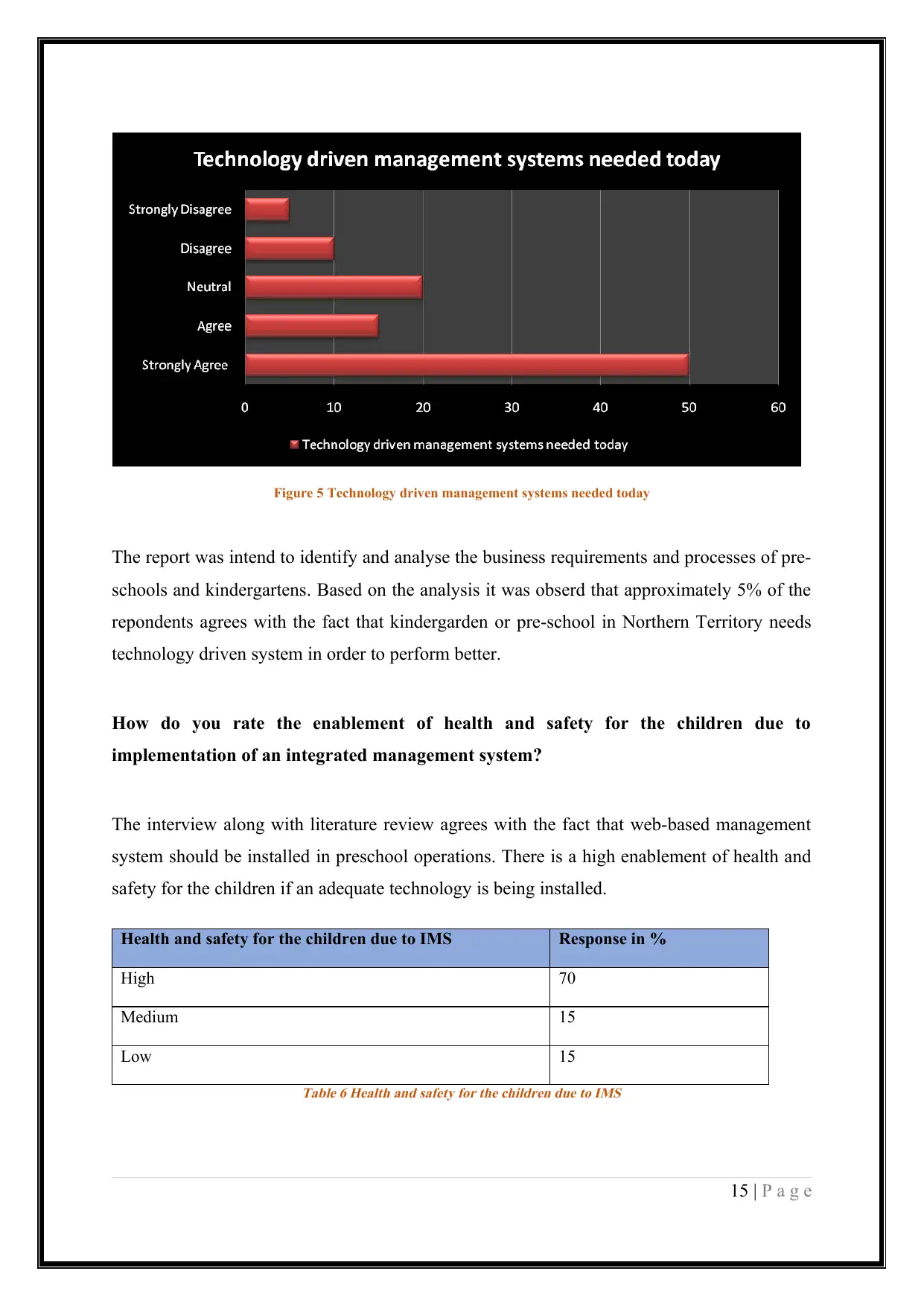
Figure 5 Technology driven management systems needed today
The report was intend to identify and analyse the business requirements and processes of pre-
schools and kindergartens. Based on the analysis it was obserd that approximately 5% of the
repondents agrees with the fact that kindergarden or pre-school in Northern Territory needs
technology driven system in order to perform better.
How do you rate the enablement of health and safety for the children due to
implementation of an integrated management system?
The interview along with literature review agrees with the fact that web-based management
system should be installed in preschool operations. There is a high enablement of health and
safety for the children if an adequate technology is being installed.
Health and safety for the children due to IMS Response in %
High 70
Medium 15
Low 15
Table 6 Health and safety for the children due to IMS
15 | P a g e
The report was intend to identify and analyse the business requirements and processes of pre-
schools and kindergartens. Based on the analysis it was obserd that approximately 5% of the
repondents agrees with the fact that kindergarden or pre-school in Northern Territory needs
technology driven system in order to perform better.
How do you rate the enablement of health and safety for the children due to
implementation of an integrated management system?
The interview along with literature review agrees with the fact that web-based management
system should be installed in preschool operations. There is a high enablement of health and
safety for the children if an adequate technology is being installed.
Health and safety for the children due to IMS Response in %
High 70
Medium 15
Low 15
Table 6 Health and safety for the children due to IMS
15 | P a g e
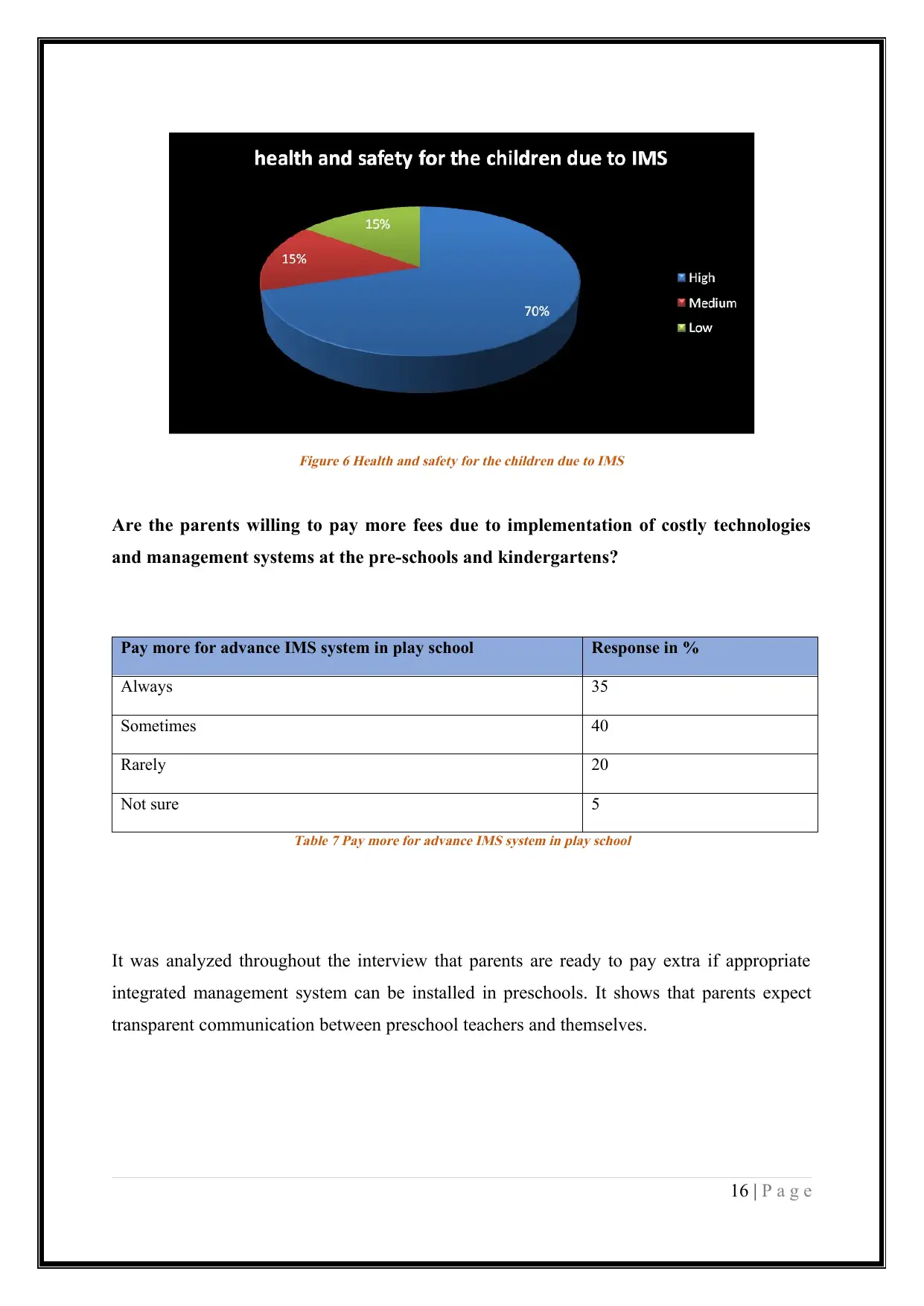
Figure 6 Health and safety for the children due to IMS
Are the parents willing to pay more fees due to implementation of costly technologies
and management systems at the pre-schools and kindergartens?
Pay more for advance IMS system in play school Response in %
Always 35
Sometimes 40
Rarely 20
Not sure 5
Table 7 Pay more for advance IMS system in play school
It was analyzed throughout the interview that parents are ready to pay extra if appropriate
integrated management system can be installed in preschools. It shows that parents expect
transparent communication between preschool teachers and themselves.
16 | P a g e
Are the parents willing to pay more fees due to implementation of costly technologies
and management systems at the pre-schools and kindergartens?
Pay more for advance IMS system in play school Response in %
Always 35
Sometimes 40
Rarely 20
Not sure 5
Table 7 Pay more for advance IMS system in play school
It was analyzed throughout the interview that parents are ready to pay extra if appropriate
integrated management system can be installed in preschools. It shows that parents expect
transparent communication between preschool teachers and themselves.
16 | P a g e
Secure Best Marks with AI Grader
Need help grading? Try our AI Grader for instant feedback on your assignments.
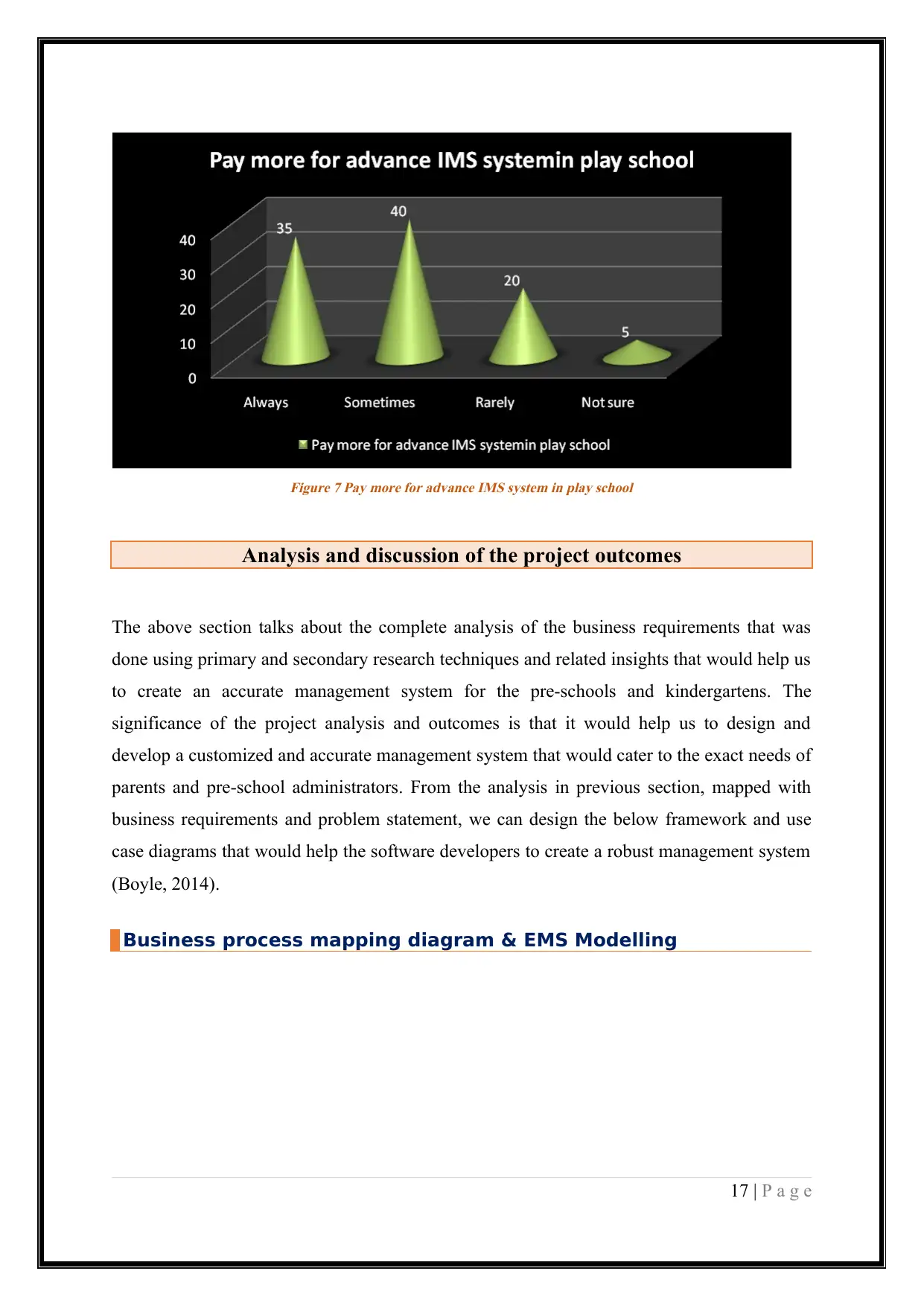
Figure 7 Pay more for advance IMS system in play school
Analysis and discussion of the project outcomes
The above section talks about the complete analysis of the business requirements that was
done using primary and secondary research techniques and related insights that would help us
to create an accurate management system for the pre-schools and kindergartens. The
significance of the project analysis and outcomes is that it would help us to design and
develop a customized and accurate management system that would cater to the exact needs of
parents and pre-school administrators. From the analysis in previous section, mapped with
business requirements and problem statement, we can design the below framework and use
case diagrams that would help the software developers to create a robust management system
(Boyle, 2014).
Business process mapping diagram & EMS Modelling
17 | P a g e
Analysis and discussion of the project outcomes
The above section talks about the complete analysis of the business requirements that was
done using primary and secondary research techniques and related insights that would help us
to create an accurate management system for the pre-schools and kindergartens. The
significance of the project analysis and outcomes is that it would help us to design and
develop a customized and accurate management system that would cater to the exact needs of
parents and pre-school administrators. From the analysis in previous section, mapped with
business requirements and problem statement, we can design the below framework and use
case diagrams that would help the software developers to create a robust management system
(Boyle, 2014).
Business process mapping diagram & EMS Modelling
17 | P a g e
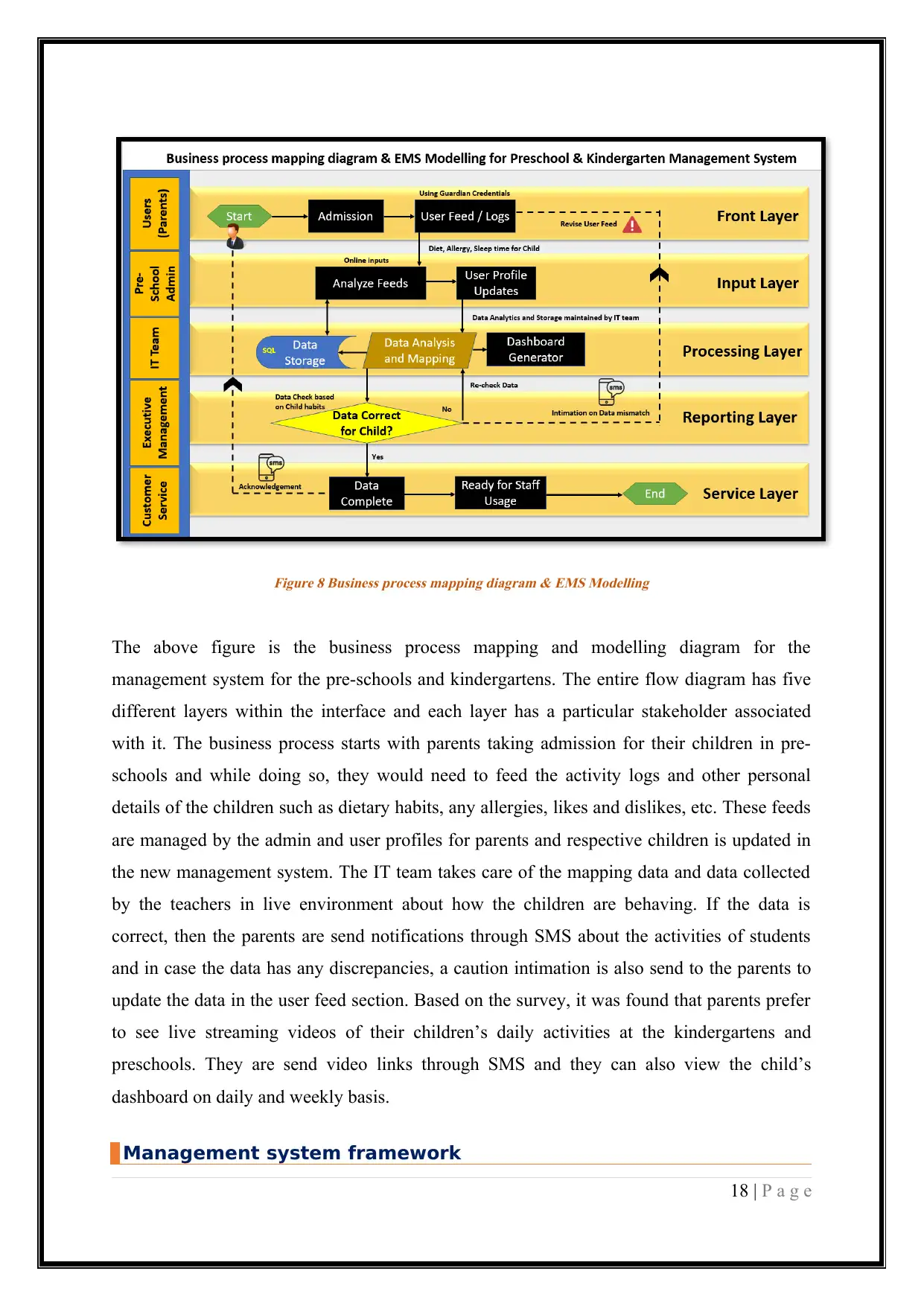
Figure 8 Business process mapping diagram & EMS Modelling
The above figure is the business process mapping and modelling diagram for the
management system for the pre-schools and kindergartens. The entire flow diagram has five
different layers within the interface and each layer has a particular stakeholder associated
with it. The business process starts with parents taking admission for their children in pre-
schools and while doing so, they would need to feed the activity logs and other personal
details of the children such as dietary habits, any allergies, likes and dislikes, etc. These feeds
are managed by the admin and user profiles for parents and respective children is updated in
the new management system. The IT team takes care of the mapping data and data collected
by the teachers in live environment about how the children are behaving. If the data is
correct, then the parents are send notifications through SMS about the activities of students
and in case the data has any discrepancies, a caution intimation is also send to the parents to
update the data in the user feed section. Based on the survey, it was found that parents prefer
to see live streaming videos of their children’s daily activities at the kindergartens and
preschools. They are send video links through SMS and they can also view the child’s
dashboard on daily and weekly basis.
Management system framework
18 | P a g e
The above figure is the business process mapping and modelling diagram for the
management system for the pre-schools and kindergartens. The entire flow diagram has five
different layers within the interface and each layer has a particular stakeholder associated
with it. The business process starts with parents taking admission for their children in pre-
schools and while doing so, they would need to feed the activity logs and other personal
details of the children such as dietary habits, any allergies, likes and dislikes, etc. These feeds
are managed by the admin and user profiles for parents and respective children is updated in
the new management system. The IT team takes care of the mapping data and data collected
by the teachers in live environment about how the children are behaving. If the data is
correct, then the parents are send notifications through SMS about the activities of students
and in case the data has any discrepancies, a caution intimation is also send to the parents to
update the data in the user feed section. Based on the survey, it was found that parents prefer
to see live streaming videos of their children’s daily activities at the kindergartens and
preschools. They are send video links through SMS and they can also view the child’s
dashboard on daily and weekly basis.
Management system framework
18 | P a g e
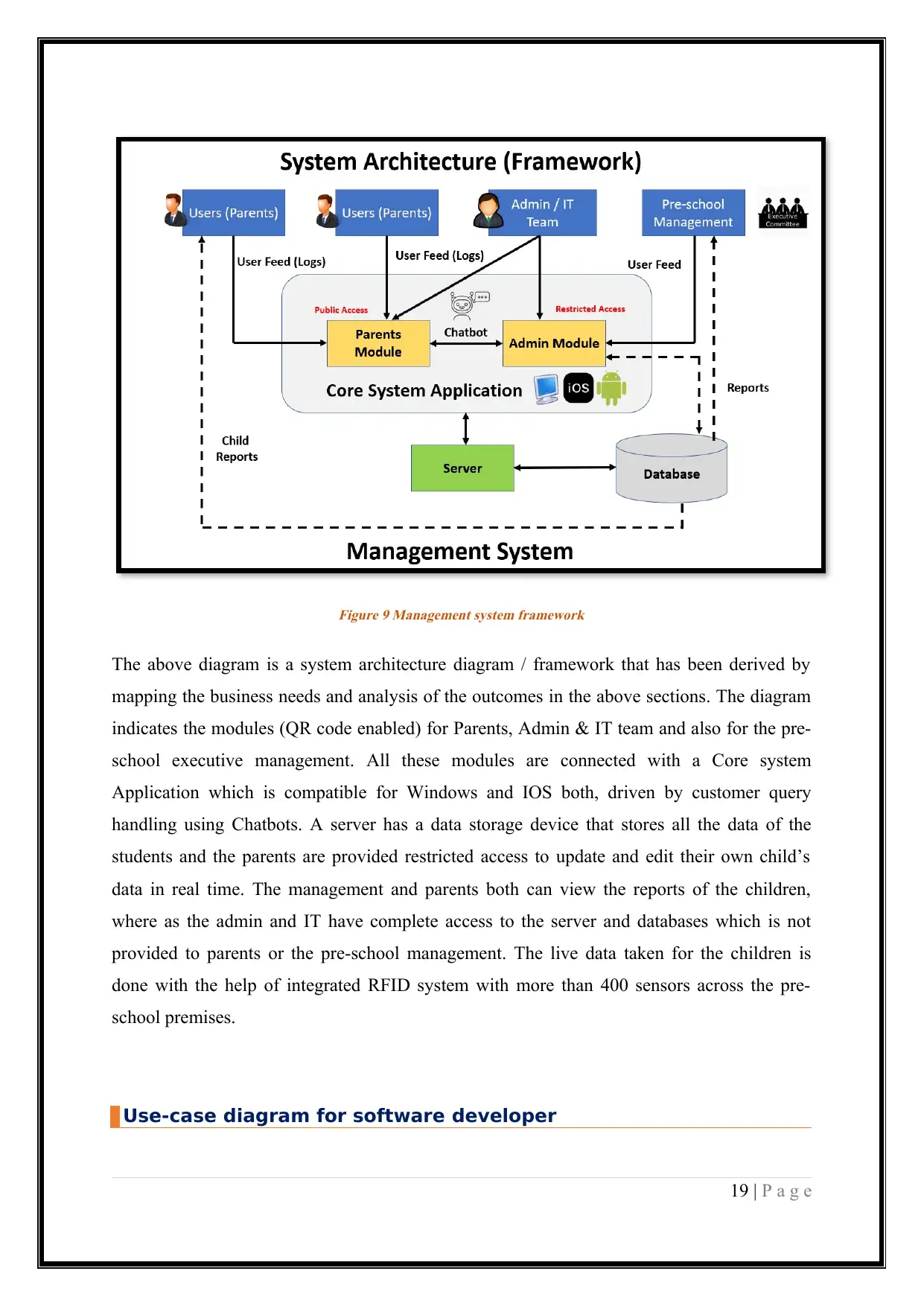
Figure 9 Management system framework
The above diagram is a system architecture diagram / framework that has been derived by
mapping the business needs and analysis of the outcomes in the above sections. The diagram
indicates the modules (QR code enabled) for Parents, Admin & IT team and also for the pre-
school executive management. All these modules are connected with a Core system
Application which is compatible for Windows and IOS both, driven by customer query
handling using Chatbots. A server has a data storage device that stores all the data of the
students and the parents are provided restricted access to update and edit their own child’s
data in real time. The management and parents both can view the reports of the children,
where as the admin and IT have complete access to the server and databases which is not
provided to parents or the pre-school management. The live data taken for the children is
done with the help of integrated RFID system with more than 400 sensors across the pre-
school premises.
Use-case diagram for software developer
19 | P a g e
The above diagram is a system architecture diagram / framework that has been derived by
mapping the business needs and analysis of the outcomes in the above sections. The diagram
indicates the modules (QR code enabled) for Parents, Admin & IT team and also for the pre-
school executive management. All these modules are connected with a Core system
Application which is compatible for Windows and IOS both, driven by customer query
handling using Chatbots. A server has a data storage device that stores all the data of the
students and the parents are provided restricted access to update and edit their own child’s
data in real time. The management and parents both can view the reports of the children,
where as the admin and IT have complete access to the server and databases which is not
provided to parents or the pre-school management. The live data taken for the children is
done with the help of integrated RFID system with more than 400 sensors across the pre-
school premises.
Use-case diagram for software developer
19 | P a g e
Paraphrase This Document
Need a fresh take? Get an instant paraphrase of this document with our AI Paraphraser
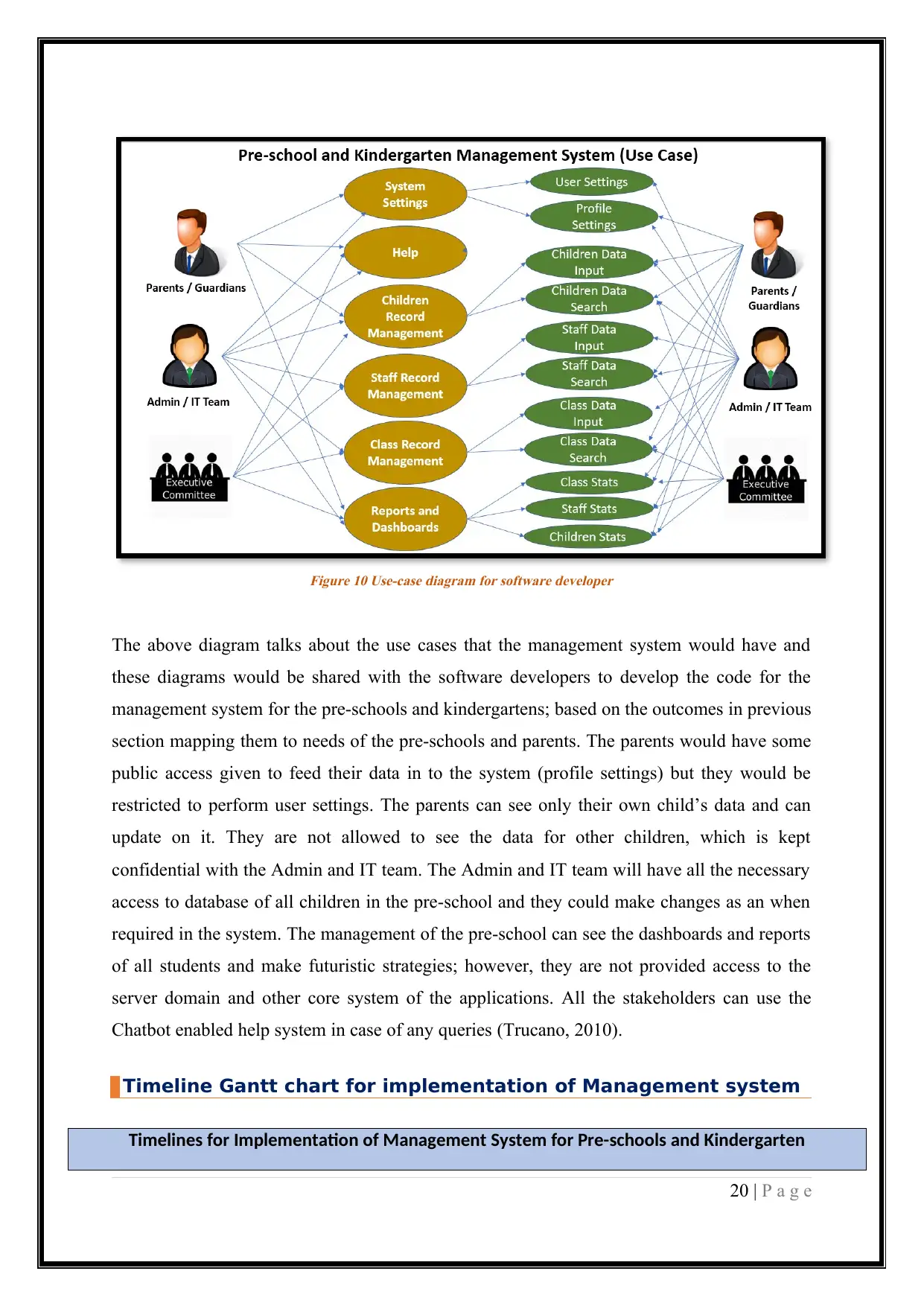
Figure 10 Use-case diagram for software developer
The above diagram talks about the use cases that the management system would have and
these diagrams would be shared with the software developers to develop the code for the
management system for the pre-schools and kindergartens; based on the outcomes in previous
section mapping them to needs of the pre-schools and parents. The parents would have some
public access given to feed their data in to the system (profile settings) but they would be
restricted to perform user settings. The parents can see only their own child’s data and can
update on it. They are not allowed to see the data for other children, which is kept
confidential with the Admin and IT team. The Admin and IT team will have all the necessary
access to database of all children in the pre-school and they could make changes as an when
required in the system. The management of the pre-school can see the dashboards and reports
of all students and make futuristic strategies; however, they are not provided access to the
server domain and other core system of the applications. All the stakeholders can use the
Chatbot enabled help system in case of any queries (Trucano, 2010).
Timeline Gantt chart for implementation of Management system
Timelines for Implementation of Management System for Pre-schools and Kindergarten
20 | P a g e
The above diagram talks about the use cases that the management system would have and
these diagrams would be shared with the software developers to develop the code for the
management system for the pre-schools and kindergartens; based on the outcomes in previous
section mapping them to needs of the pre-schools and parents. The parents would have some
public access given to feed their data in to the system (profile settings) but they would be
restricted to perform user settings. The parents can see only their own child’s data and can
update on it. They are not allowed to see the data for other children, which is kept
confidential with the Admin and IT team. The Admin and IT team will have all the necessary
access to database of all children in the pre-school and they could make changes as an when
required in the system. The management of the pre-school can see the dashboards and reports
of all students and make futuristic strategies; however, they are not provided access to the
server domain and other core system of the applications. All the stakeholders can use the
Chatbot enabled help system in case of any queries (Trucano, 2010).
Timeline Gantt chart for implementation of Management system
Timelines for Implementation of Management System for Pre-schools and Kindergarten
20 | P a g e
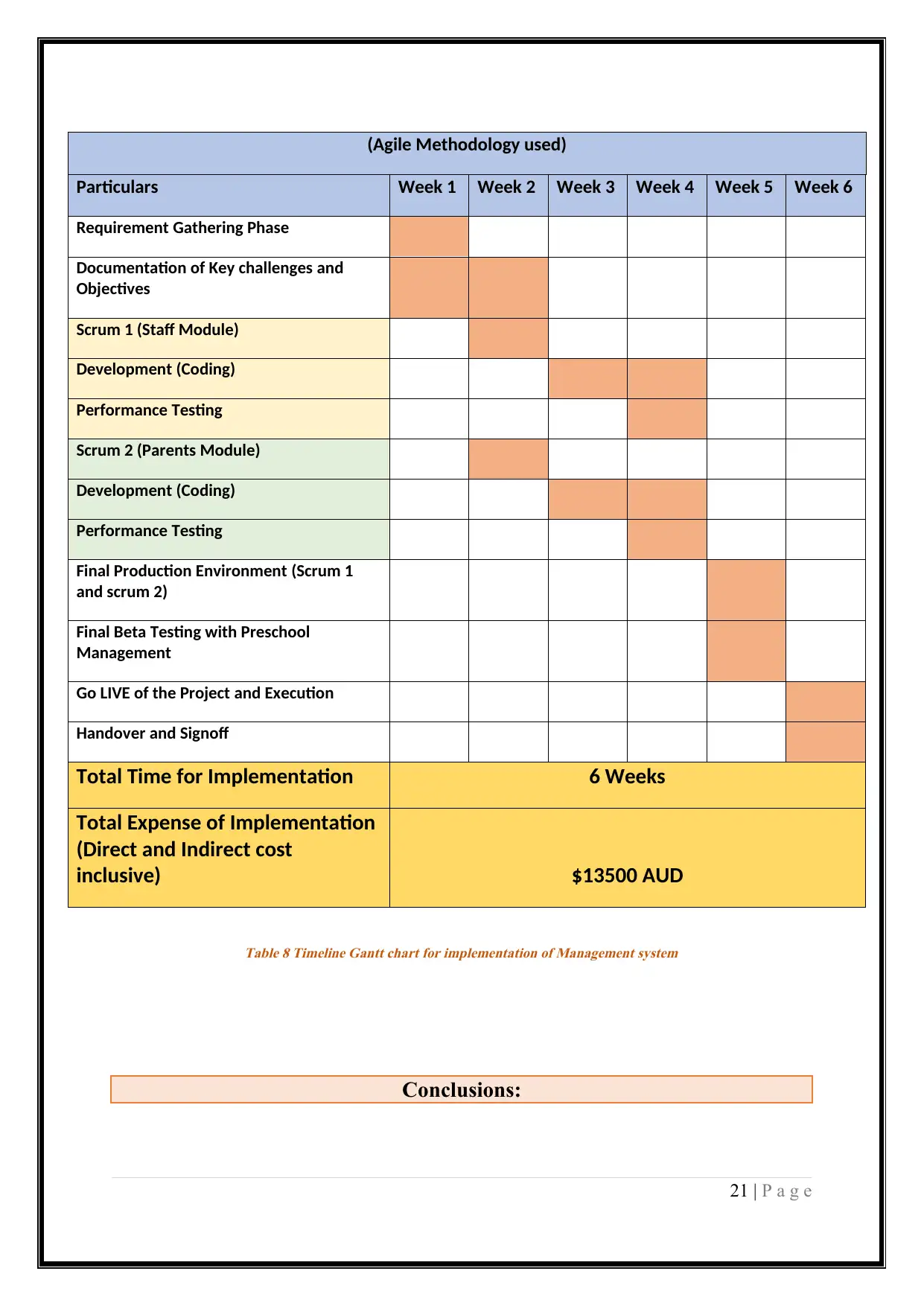
(Agile Methodology used)
Particulars Week 1 Week 2 Week 3 Week 4 Week 5 Week 6
Requirement Gathering Phase
Documentation of Key challenges and
Objectives
Scrum 1 (Staff Module)
Development (Coding)
Performance Testing
Scrum 2 (Parents Module)
Development (Coding)
Performance Testing
Final Production Environment (Scrum 1
and scrum 2)
Final Beta Testing with Preschool
Management
Go LIVE of the Project and Execution
Handover and Signoff
Total Time for Implementation 6 Weeks
Total Expense of Implementation
(Direct and Indirect cost
inclusive) $13500 AUDTable 8 Timeline Gantt chart for implementation of Management system
Conclusions:
21 | P a g e
Particulars Week 1 Week 2 Week 3 Week 4 Week 5 Week 6
Requirement Gathering Phase
Documentation of Key challenges and
Objectives
Scrum 1 (Staff Module)
Development (Coding)
Performance Testing
Scrum 2 (Parents Module)
Development (Coding)
Performance Testing
Final Production Environment (Scrum 1
and scrum 2)
Final Beta Testing with Preschool
Management
Go LIVE of the Project and Execution
Handover and Signoff
Total Time for Implementation 6 Weeks
Total Expense of Implementation
(Direct and Indirect cost
inclusive) $13500 AUDTable 8 Timeline Gantt chart for implementation of Management system
Conclusions:
21 | P a g e
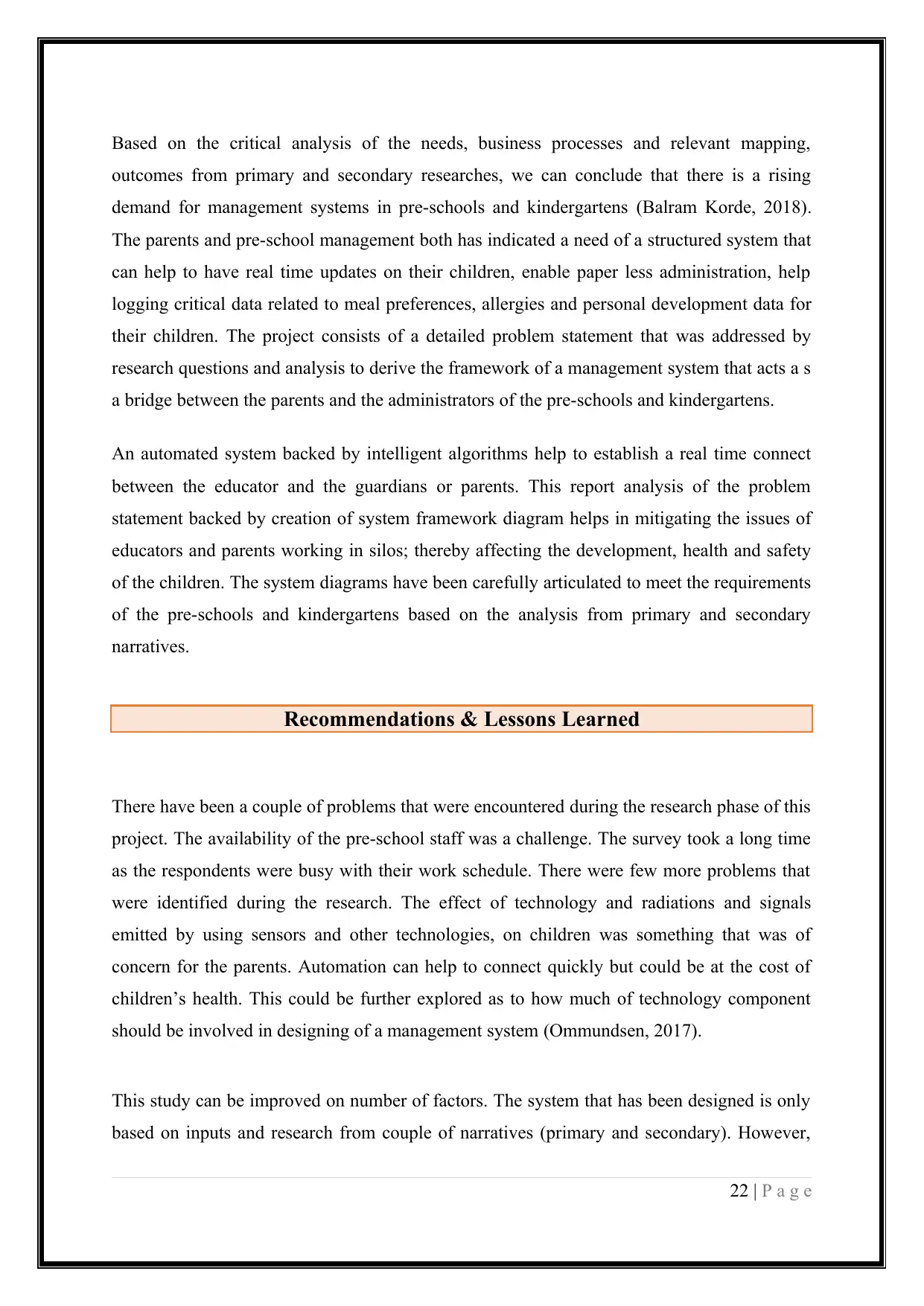
Based on the critical analysis of the needs, business processes and relevant mapping,
outcomes from primary and secondary researches, we can conclude that there is a rising
demand for management systems in pre-schools and kindergartens (Balram Korde, 2018).
The parents and pre-school management both has indicated a need of a structured system that
can help to have real time updates on their children, enable paper less administration, help
logging critical data related to meal preferences, allergies and personal development data for
their children. The project consists of a detailed problem statement that was addressed by
research questions and analysis to derive the framework of a management system that acts a s
a bridge between the parents and the administrators of the pre-schools and kindergartens.
An automated system backed by intelligent algorithms help to establish a real time connect
between the educator and the guardians or parents. This report analysis of the problem
statement backed by creation of system framework diagram helps in mitigating the issues of
educators and parents working in silos; thereby affecting the development, health and safety
of the children. The system diagrams have been carefully articulated to meet the requirements
of the pre-schools and kindergartens based on the analysis from primary and secondary
narratives.
Recommendations & Lessons Learned
There have been a couple of problems that were encountered during the research phase of this
project. The availability of the pre-school staff was a challenge. The survey took a long time
as the respondents were busy with their work schedule. There were few more problems that
were identified during the research. The effect of technology and radiations and signals
emitted by using sensors and other technologies, on children was something that was of
concern for the parents. Automation can help to connect quickly but could be at the cost of
children’s health. This could be further explored as to how much of technology component
should be involved in designing of a management system (Ommundsen, 2017).
This study can be improved on number of factors. The system that has been designed is only
based on inputs and research from couple of narratives (primary and secondary). However,
22 | P a g e
outcomes from primary and secondary researches, we can conclude that there is a rising
demand for management systems in pre-schools and kindergartens (Balram Korde, 2018).
The parents and pre-school management both has indicated a need of a structured system that
can help to have real time updates on their children, enable paper less administration, help
logging critical data related to meal preferences, allergies and personal development data for
their children. The project consists of a detailed problem statement that was addressed by
research questions and analysis to derive the framework of a management system that acts a s
a bridge between the parents and the administrators of the pre-schools and kindergartens.
An automated system backed by intelligent algorithms help to establish a real time connect
between the educator and the guardians or parents. This report analysis of the problem
statement backed by creation of system framework diagram helps in mitigating the issues of
educators and parents working in silos; thereby affecting the development, health and safety
of the children. The system diagrams have been carefully articulated to meet the requirements
of the pre-schools and kindergartens based on the analysis from primary and secondary
narratives.
Recommendations & Lessons Learned
There have been a couple of problems that were encountered during the research phase of this
project. The availability of the pre-school staff was a challenge. The survey took a long time
as the respondents were busy with their work schedule. There were few more problems that
were identified during the research. The effect of technology and radiations and signals
emitted by using sensors and other technologies, on children was something that was of
concern for the parents. Automation can help to connect quickly but could be at the cost of
children’s health. This could be further explored as to how much of technology component
should be involved in designing of a management system (Ommundsen, 2017).
This study can be improved on number of factors. The system that has been designed is only
based on inputs and research from couple of narratives (primary and secondary). However,
22 | P a g e
Secure Best Marks with AI Grader
Need help grading? Try our AI Grader for instant feedback on your assignments.
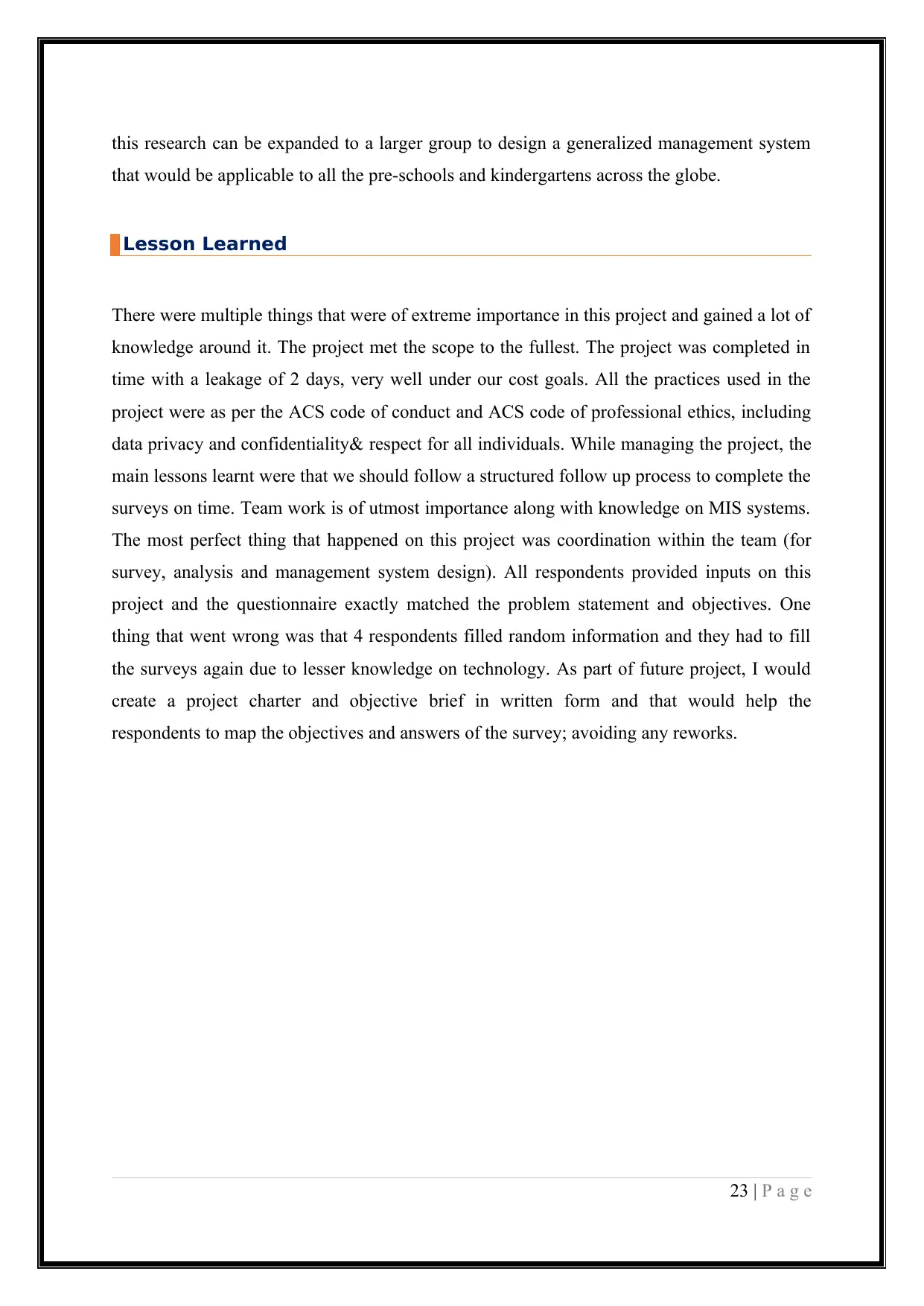
this research can be expanded to a larger group to design a generalized management system
that would be applicable to all the pre-schools and kindergartens across the globe.
Lesson Learned
There were multiple things that were of extreme importance in this project and gained a lot of
knowledge around it. The project met the scope to the fullest. The project was completed in
time with a leakage of 2 days, very well under our cost goals. All the practices used in the
project were as per the ACS code of conduct and ACS code of professional ethics, including
data privacy and confidentiality& respect for all individuals. While managing the project, the
main lessons learnt were that we should follow a structured follow up process to complete the
surveys on time. Team work is of utmost importance along with knowledge on MIS systems.
The most perfect thing that happened on this project was coordination within the team (for
survey, analysis and management system design). All respondents provided inputs on this
project and the questionnaire exactly matched the problem statement and objectives. One
thing that went wrong was that 4 respondents filled random information and they had to fill
the surveys again due to lesser knowledge on technology. As part of future project, I would
create a project charter and objective brief in written form and that would help the
respondents to map the objectives and answers of the survey; avoiding any reworks.
23 | P a g e
that would be applicable to all the pre-schools and kindergartens across the globe.
Lesson Learned
There were multiple things that were of extreme importance in this project and gained a lot of
knowledge around it. The project met the scope to the fullest. The project was completed in
time with a leakage of 2 days, very well under our cost goals. All the practices used in the
project were as per the ACS code of conduct and ACS code of professional ethics, including
data privacy and confidentiality& respect for all individuals. While managing the project, the
main lessons learnt were that we should follow a structured follow up process to complete the
surveys on time. Team work is of utmost importance along with knowledge on MIS systems.
The most perfect thing that happened on this project was coordination within the team (for
survey, analysis and management system design). All respondents provided inputs on this
project and the questionnaire exactly matched the problem statement and objectives. One
thing that went wrong was that 4 respondents filled random information and they had to fill
the surveys again due to lesser knowledge on technology. As part of future project, I would
create a project charter and objective brief in written form and that would help the
respondents to map the objectives and answers of the survey; avoiding any reworks.
23 | P a g e
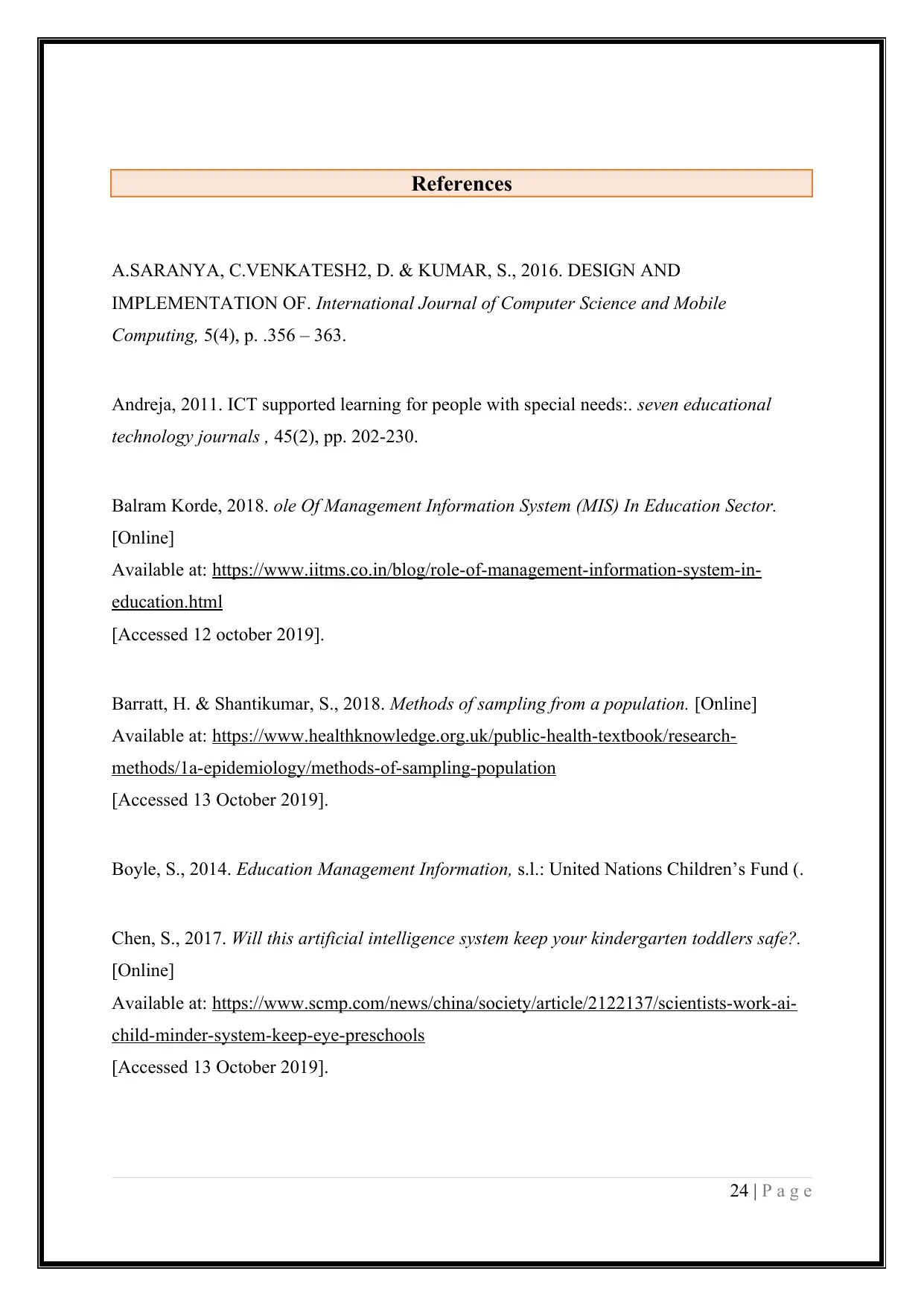
References
A.SARANYA, C.VENKATESH2, D. & KUMAR, S., 2016. DESIGN AND
IMPLEMENTATION OF. International Journal of Computer Science and Mobile
Computing, 5(4), p. .356 – 363.
Andreja, 2011. ICT supported learning for people with special needs:. seven educational
technology journals , 45(2), pp. 202-230.
Balram Korde, 2018. ole Of Management Information System (MIS) In Education Sector.
[Online]
Available at: https://www.iitms.co.in/blog/role-of-management-information-system-in-
education.html
[Accessed 12 october 2019].
Barratt, H. & Shantikumar, S., 2018. Methods of sampling from a population. [Online]
Available at: https://www.healthknowledge.org.uk/public-health-textbook/research-
methods/1a-epidemiology/methods-of-sampling-population
[Accessed 13 October 2019].
Boyle, S., 2014. Education Management Information, s.l.: United Nations Children’s Fund (.
Chen, S., 2017. Will this artificial intelligence system keep your kindergarten toddlers safe?.
[Online]
Available at: https://www.scmp.com/news/china/society/article/2122137/scientists-work-ai-
child-minder-system-keep-eye-preschools
[Accessed 13 October 2019].
24 | P a g e
A.SARANYA, C.VENKATESH2, D. & KUMAR, S., 2016. DESIGN AND
IMPLEMENTATION OF. International Journal of Computer Science and Mobile
Computing, 5(4), p. .356 – 363.
Andreja, 2011. ICT supported learning for people with special needs:. seven educational
technology journals , 45(2), pp. 202-230.
Balram Korde, 2018. ole Of Management Information System (MIS) In Education Sector.
[Online]
Available at: https://www.iitms.co.in/blog/role-of-management-information-system-in-
education.html
[Accessed 12 october 2019].
Barratt, H. & Shantikumar, S., 2018. Methods of sampling from a population. [Online]
Available at: https://www.healthknowledge.org.uk/public-health-textbook/research-
methods/1a-epidemiology/methods-of-sampling-population
[Accessed 13 October 2019].
Boyle, S., 2014. Education Management Information, s.l.: United Nations Children’s Fund (.
Chen, S., 2017. Will this artificial intelligence system keep your kindergarten toddlers safe?.
[Online]
Available at: https://www.scmp.com/news/china/society/article/2122137/scientists-work-ai-
child-minder-system-keep-eye-preschools
[Accessed 13 October 2019].
24 | P a g e
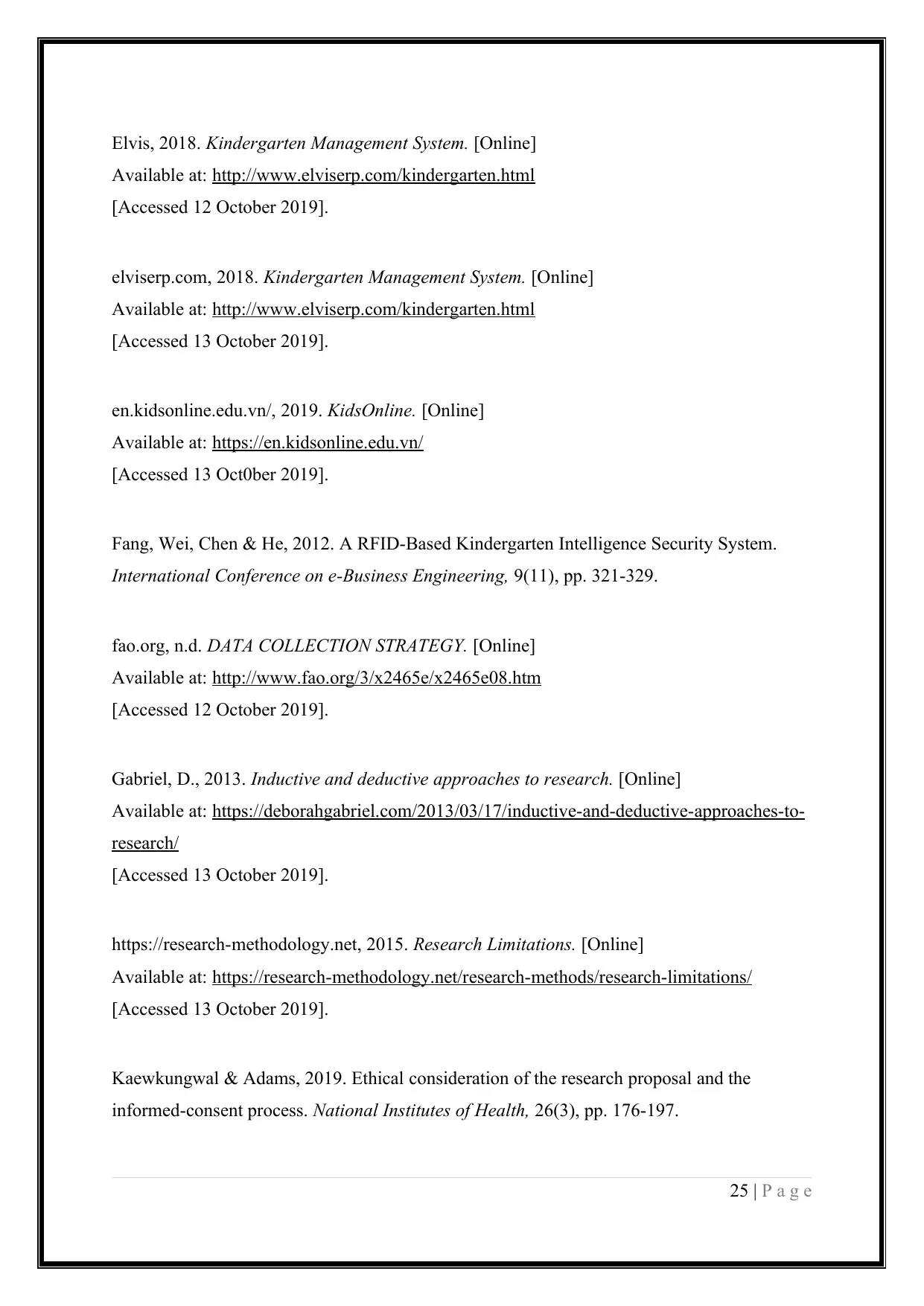
Elvis, 2018. Kindergarten Management System. [Online]
Available at: http://www.elviserp.com/kindergarten.html
[Accessed 12 October 2019].
elviserp.com, 2018. Kindergarten Management System. [Online]
Available at: http://www.elviserp.com/kindergarten.html
[Accessed 13 October 2019].
en.kidsonline.edu.vn/, 2019. KidsOnline. [Online]
Available at: https://en.kidsonline.edu.vn/
[Accessed 13 Oct0ber 2019].
Fang, Wei, Chen & He, 2012. A RFID-Based Kindergarten Intelligence Security System.
International Conference on e-Business Engineering, 9(11), pp. 321-329.
fao.org, n.d. DATA COLLECTION STRATEGY. [Online]
Available at: http://www.fao.org/3/x2465e/x2465e08.htm
[Accessed 12 October 2019].
Gabriel, D., 2013. Inductive and deductive approaches to research. [Online]
Available at: https://deborahgabriel.com/2013/03/17/inductive-and-deductive-approaches-to-
research/
[Accessed 13 October 2019].
https://research-methodology.net, 2015. Research Limitations. [Online]
Available at: https://research-methodology.net/research-methods/research-limitations/
[Accessed 13 October 2019].
Kaewkungwal & Adams, 2019. Ethical consideration of the research proposal and the
informed-consent process. National Institutes of Health, 26(3), pp. 176-197.
25 | P a g e
Available at: http://www.elviserp.com/kindergarten.html
[Accessed 12 October 2019].
elviserp.com, 2018. Kindergarten Management System. [Online]
Available at: http://www.elviserp.com/kindergarten.html
[Accessed 13 October 2019].
en.kidsonline.edu.vn/, 2019. KidsOnline. [Online]
Available at: https://en.kidsonline.edu.vn/
[Accessed 13 Oct0ber 2019].
Fang, Wei, Chen & He, 2012. A RFID-Based Kindergarten Intelligence Security System.
International Conference on e-Business Engineering, 9(11), pp. 321-329.
fao.org, n.d. DATA COLLECTION STRATEGY. [Online]
Available at: http://www.fao.org/3/x2465e/x2465e08.htm
[Accessed 12 October 2019].
Gabriel, D., 2013. Inductive and deductive approaches to research. [Online]
Available at: https://deborahgabriel.com/2013/03/17/inductive-and-deductive-approaches-to-
research/
[Accessed 13 October 2019].
https://research-methodology.net, 2015. Research Limitations. [Online]
Available at: https://research-methodology.net/research-methods/research-limitations/
[Accessed 13 October 2019].
Kaewkungwal & Adams, 2019. Ethical consideration of the research proposal and the
informed-consent process. National Institutes of Health, 26(3), pp. 176-197.
25 | P a g e
Paraphrase This Document
Need a fresh take? Get an instant paraphrase of this document with our AI Paraphraser
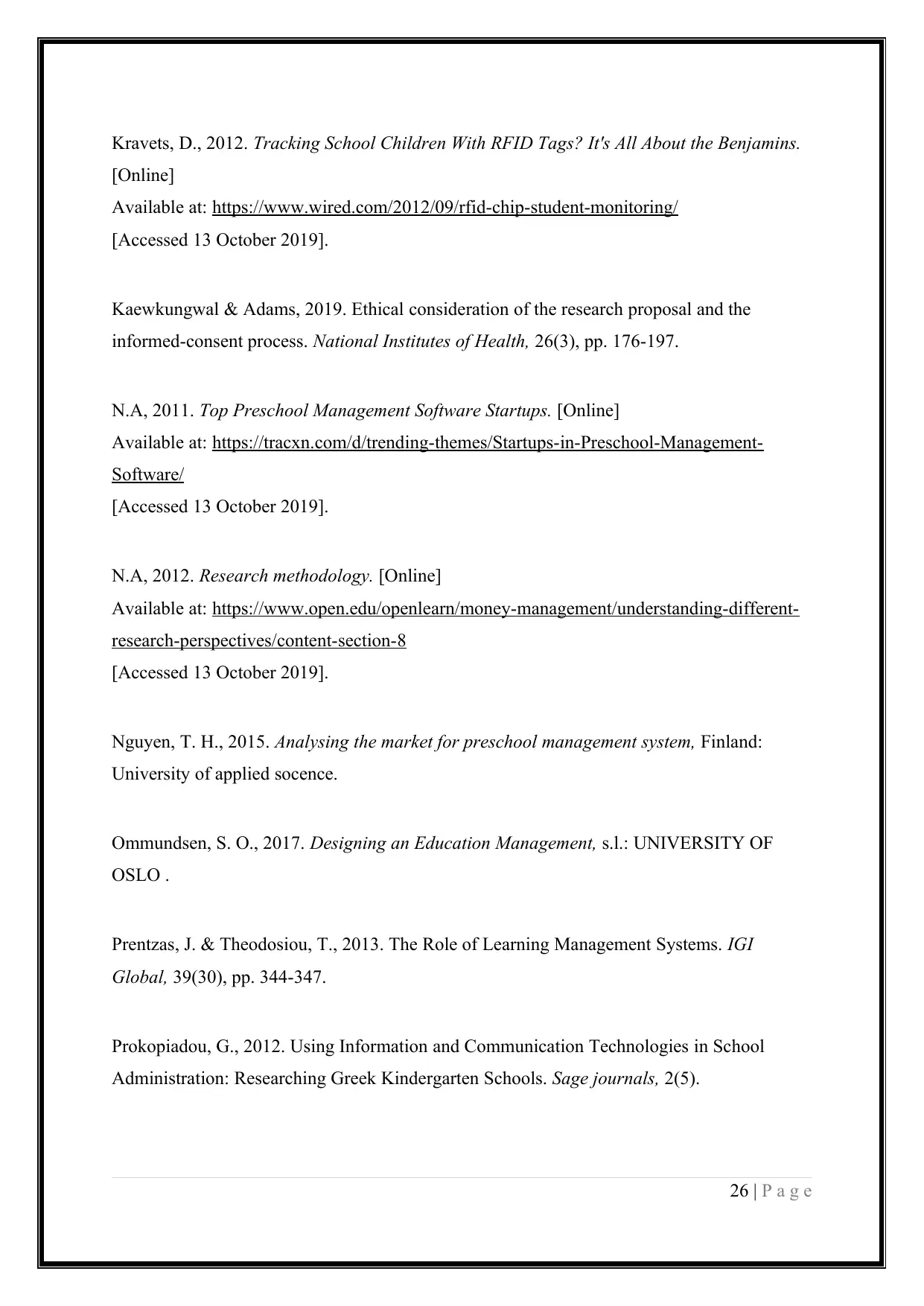
Kravets, D., 2012. Tracking School Children With RFID Tags? It's All About the Benjamins.
[Online]
Available at: https://www.wired.com/2012/09/rfid-chip-student-monitoring/
[Accessed 13 October 2019].
Kaewkungwal & Adams, 2019. Ethical consideration of the research proposal and the
informed-consent process. National Institutes of Health, 26(3), pp. 176-197.
N.A, 2011. Top Preschool Management Software Startups. [Online]
Available at: https://tracxn.com/d/trending-themes/Startups-in-Preschool-Management-
Software/
[Accessed 13 October 2019].
N.A, 2012. Research methodology. [Online]
Available at: https://www.open.edu/openlearn/money-management/understanding-different-
research-perspectives/content-section-8
[Accessed 13 October 2019].
Nguyen, T. H., 2015. Analysing the market for preschool management system, Finland:
University of applied socence.
Ommundsen, S. O., 2017. Designing an Education Management, s.l.: UNIVERSITY OF
OSLO .
Prentzas, J. & Theodosiou, T., 2013. The Role of Learning Management Systems. IGI
Global, 39(30), pp. 344-347.
Prokopiadou, G., 2012. Using Information and Communication Technologies in School
Administration: Researching Greek Kindergarten Schools. Sage journals, 2(5).
26 | P a g e
[Online]
Available at: https://www.wired.com/2012/09/rfid-chip-student-monitoring/
[Accessed 13 October 2019].
Kaewkungwal & Adams, 2019. Ethical consideration of the research proposal and the
informed-consent process. National Institutes of Health, 26(3), pp. 176-197.
N.A, 2011. Top Preschool Management Software Startups. [Online]
Available at: https://tracxn.com/d/trending-themes/Startups-in-Preschool-Management-
Software/
[Accessed 13 October 2019].
N.A, 2012. Research methodology. [Online]
Available at: https://www.open.edu/openlearn/money-management/understanding-different-
research-perspectives/content-section-8
[Accessed 13 October 2019].
Nguyen, T. H., 2015. Analysing the market for preschool management system, Finland:
University of applied socence.
Ommundsen, S. O., 2017. Designing an Education Management, s.l.: UNIVERSITY OF
OSLO .
Prentzas, J. & Theodosiou, T., 2013. The Role of Learning Management Systems. IGI
Global, 39(30), pp. 344-347.
Prokopiadou, G., 2012. Using Information and Communication Technologies in School
Administration: Researching Greek Kindergarten Schools. Sage journals, 2(5).
26 | P a g e
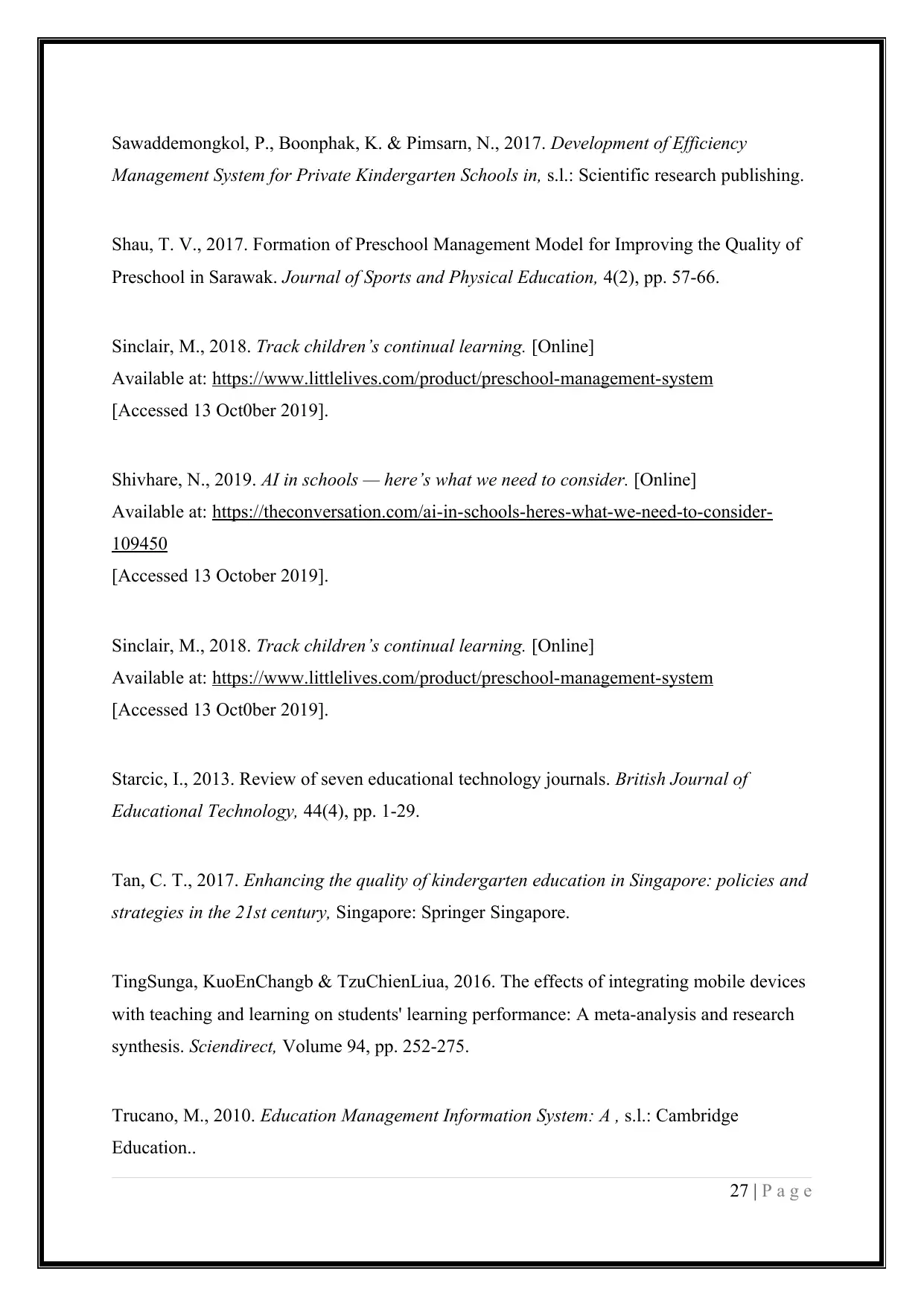
Sawaddemongkol, P., Boonphak, K. & Pimsarn, N., 2017. Development of Efficiency
Management System for Private Kindergarten Schools in, s.l.: Scientific research publishing.
Shau, T. V., 2017. Formation of Preschool Management Model for Improving the Quality of
Preschool in Sarawak. Journal of Sports and Physical Education, 4(2), pp. 57-66.
Sinclair, M., 2018. Track children’s continual learning. [Online]
Available at: https://www.littlelives.com/product/preschool-management-system
[Accessed 13 Oct0ber 2019].
Shivhare, N., 2019. AI in schools — here’s what we need to consider. [Online]
Available at: https://theconversation.com/ai-in-schools-heres-what-we-need-to-consider-
109450
[Accessed 13 October 2019].
Sinclair, M., 2018. Track children’s continual learning. [Online]
Available at: https://www.littlelives.com/product/preschool-management-system
[Accessed 13 Oct0ber 2019].
Starcic, I., 2013. Review of seven educational technology journals. British Journal of
Educational Technology, 44(4), pp. 1-29.
Tan, C. T., 2017. Enhancing the quality of kindergarten education in Singapore: policies and
strategies in the 21st century, Singapore: Springer Singapore.
TingSunga, KuoEnChangb & TzuChienLiua, 2016. The effects of integrating mobile devices
with teaching and learning on students' learning performance: A meta-analysis and research
synthesis. Sciendirect, Volume 94, pp. 252-275.
Trucano, M., 2010. Education Management Information System: A , s.l.: Cambridge
Education..
27 | P a g e
Management System for Private Kindergarten Schools in, s.l.: Scientific research publishing.
Shau, T. V., 2017. Formation of Preschool Management Model for Improving the Quality of
Preschool in Sarawak. Journal of Sports and Physical Education, 4(2), pp. 57-66.
Sinclair, M., 2018. Track children’s continual learning. [Online]
Available at: https://www.littlelives.com/product/preschool-management-system
[Accessed 13 Oct0ber 2019].
Shivhare, N., 2019. AI in schools — here’s what we need to consider. [Online]
Available at: https://theconversation.com/ai-in-schools-heres-what-we-need-to-consider-
109450
[Accessed 13 October 2019].
Sinclair, M., 2018. Track children’s continual learning. [Online]
Available at: https://www.littlelives.com/product/preschool-management-system
[Accessed 13 Oct0ber 2019].
Starcic, I., 2013. Review of seven educational technology journals. British Journal of
Educational Technology, 44(4), pp. 1-29.
Tan, C. T., 2017. Enhancing the quality of kindergarten education in Singapore: policies and
strategies in the 21st century, Singapore: Springer Singapore.
TingSunga, KuoEnChangb & TzuChienLiua, 2016. The effects of integrating mobile devices
with teaching and learning on students' learning performance: A meta-analysis and research
synthesis. Sciendirect, Volume 94, pp. 252-275.
Trucano, M., 2010. Education Management Information System: A , s.l.: Cambridge
Education..
27 | P a g e
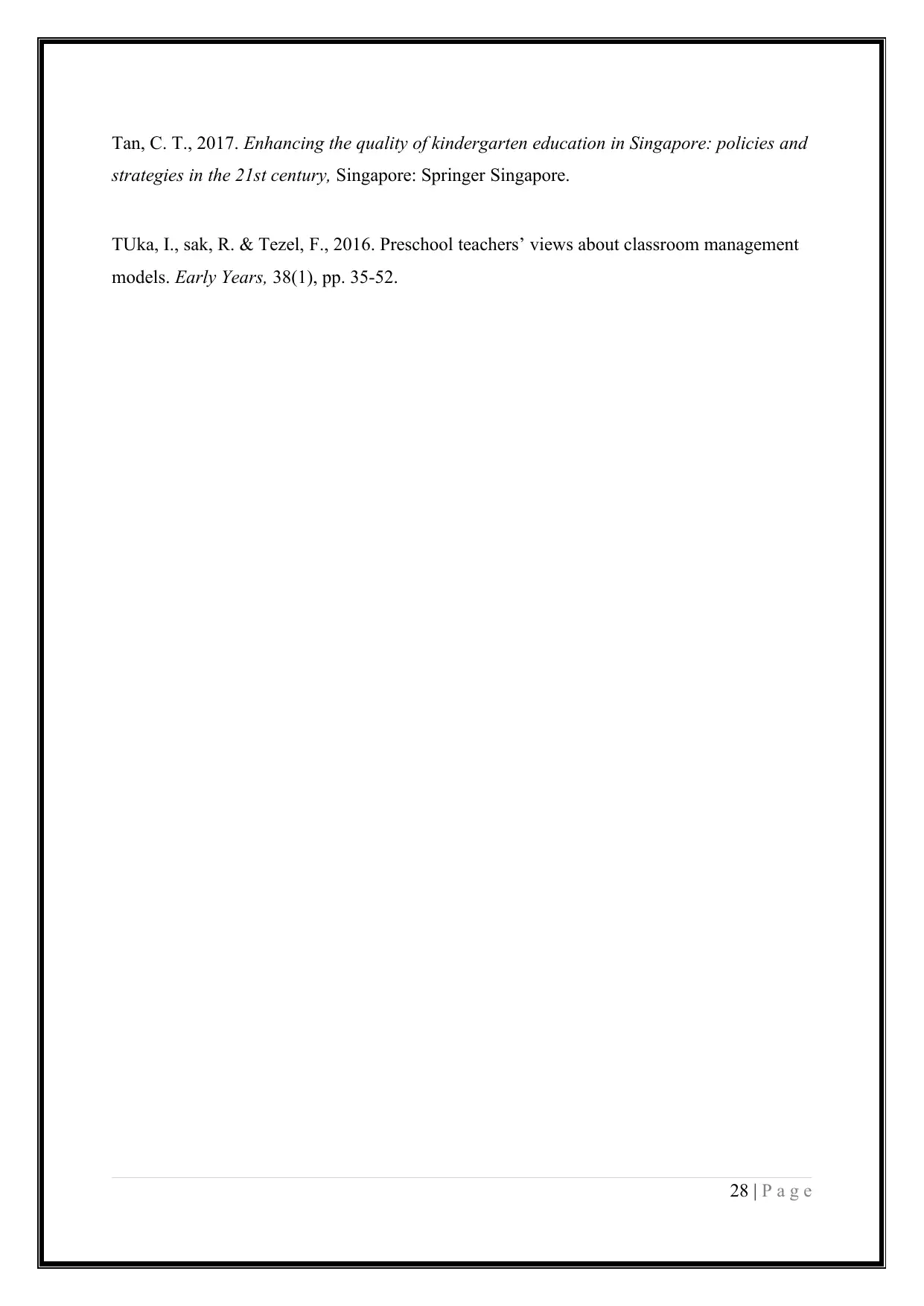
Tan, C. T., 2017. Enhancing the quality of kindergarten education in Singapore: policies and
strategies in the 21st century, Singapore: Springer Singapore.
TUka, I., sak, R. & Tezel, F., 2016. Preschool teachers’ views about classroom management
models. Early Years, 38(1), pp. 35-52.
28 | P a g e
strategies in the 21st century, Singapore: Springer Singapore.
TUka, I., sak, R. & Tezel, F., 2016. Preschool teachers’ views about classroom management
models. Early Years, 38(1), pp. 35-52.
28 | P a g e
Secure Best Marks with AI Grader
Need help grading? Try our AI Grader for instant feedback on your assignments.
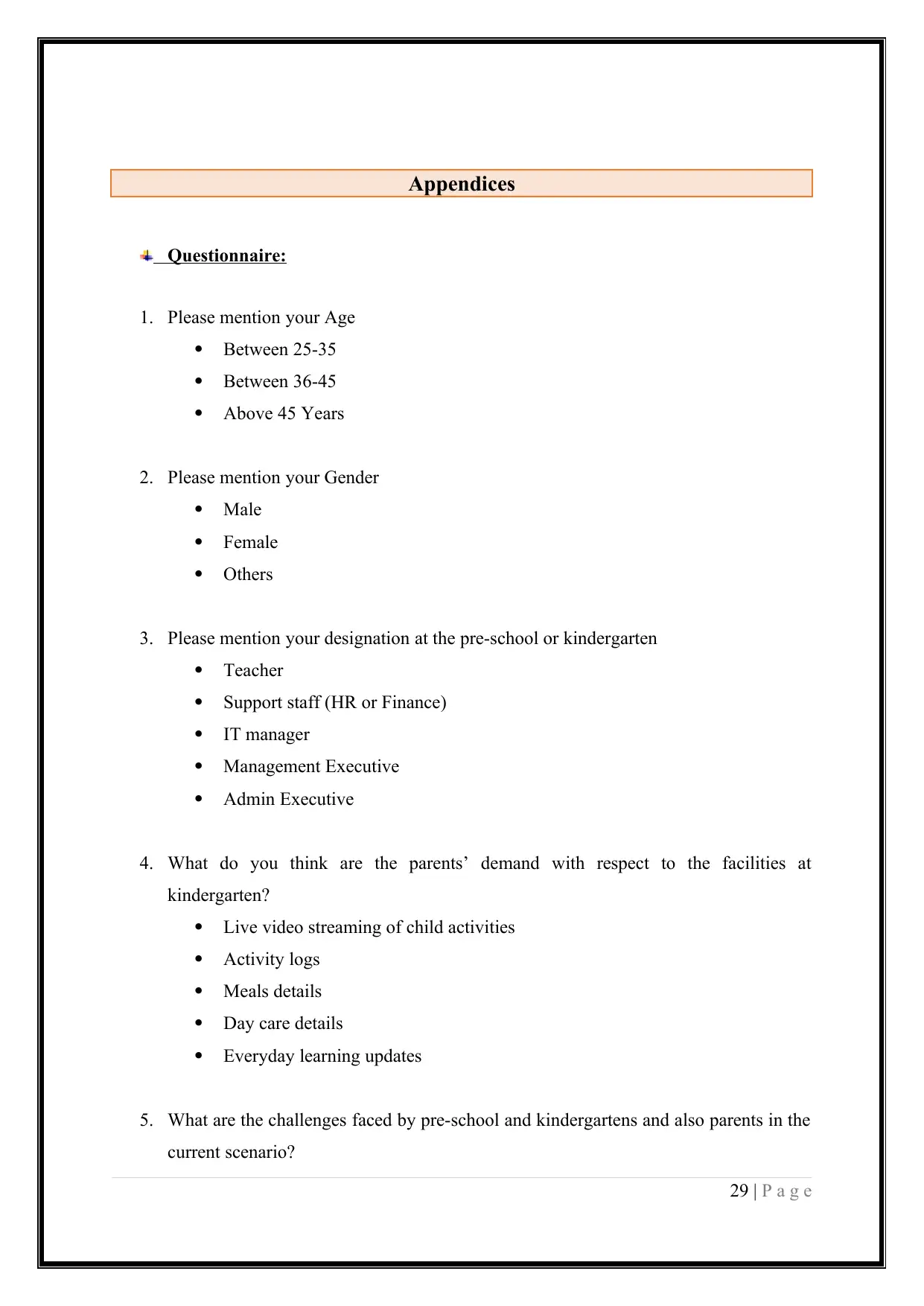
Appendices
Questionnaire:
1. Please mention your Age
Between 25-35
Between 36-45
Above 45 Years
2. Please mention your Gender
Male
Female
Others
3. Please mention your designation at the pre-school or kindergarten
Teacher
Support staff (HR or Finance)
IT manager
Management Executive
Admin Executive
4. What do you think are the parents’ demand with respect to the facilities at
kindergarten?
Live video streaming of child activities
Activity logs
Meals details
Day care details
Everyday learning updates
5. What are the challenges faced by pre-school and kindergartens and also parents in the
current scenario?
29 | P a g e
Questionnaire:
1. Please mention your Age
Between 25-35
Between 36-45
Above 45 Years
2. Please mention your Gender
Male
Female
Others
3. Please mention your designation at the pre-school or kindergarten
Teacher
Support staff (HR or Finance)
IT manager
Management Executive
Admin Executive
4. What do you think are the parents’ demand with respect to the facilities at
kindergarten?
Live video streaming of child activities
Activity logs
Meals details
Day care details
Everyday learning updates
5. What are the challenges faced by pre-school and kindergartens and also parents in the
current scenario?
29 | P a g e
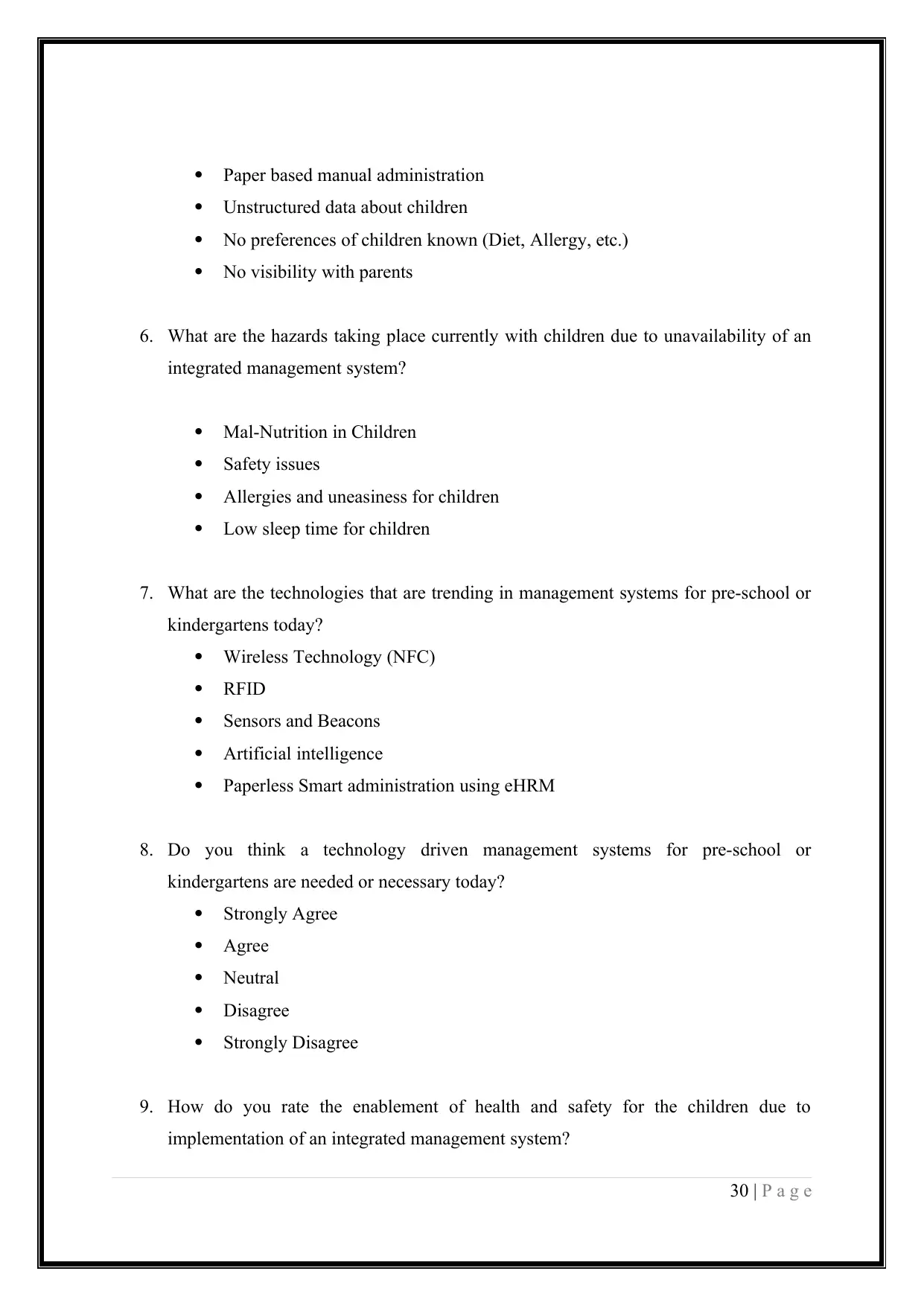
Paper based manual administration
Unstructured data about children
No preferences of children known (Diet, Allergy, etc.)
No visibility with parents
6. What are the hazards taking place currently with children due to unavailability of an
integrated management system?
Mal-Nutrition in Children
Safety issues
Allergies and uneasiness for children
Low sleep time for children
7. What are the technologies that are trending in management systems for pre-school or
kindergartens today?
Wireless Technology (NFC)
RFID
Sensors and Beacons
Artificial intelligence
Paperless Smart administration using eHRM
8. Do you think a technology driven management systems for pre-school or
kindergartens are needed or necessary today?
Strongly Agree
Agree
Neutral
Disagree
Strongly Disagree
9. How do you rate the enablement of health and safety for the children due to
implementation of an integrated management system?
30 | P a g e
Unstructured data about children
No preferences of children known (Diet, Allergy, etc.)
No visibility with parents
6. What are the hazards taking place currently with children due to unavailability of an
integrated management system?
Mal-Nutrition in Children
Safety issues
Allergies and uneasiness for children
Low sleep time for children
7. What are the technologies that are trending in management systems for pre-school or
kindergartens today?
Wireless Technology (NFC)
RFID
Sensors and Beacons
Artificial intelligence
Paperless Smart administration using eHRM
8. Do you think a technology driven management systems for pre-school or
kindergartens are needed or necessary today?
Strongly Agree
Agree
Neutral
Disagree
Strongly Disagree
9. How do you rate the enablement of health and safety for the children due to
implementation of an integrated management system?
30 | P a g e
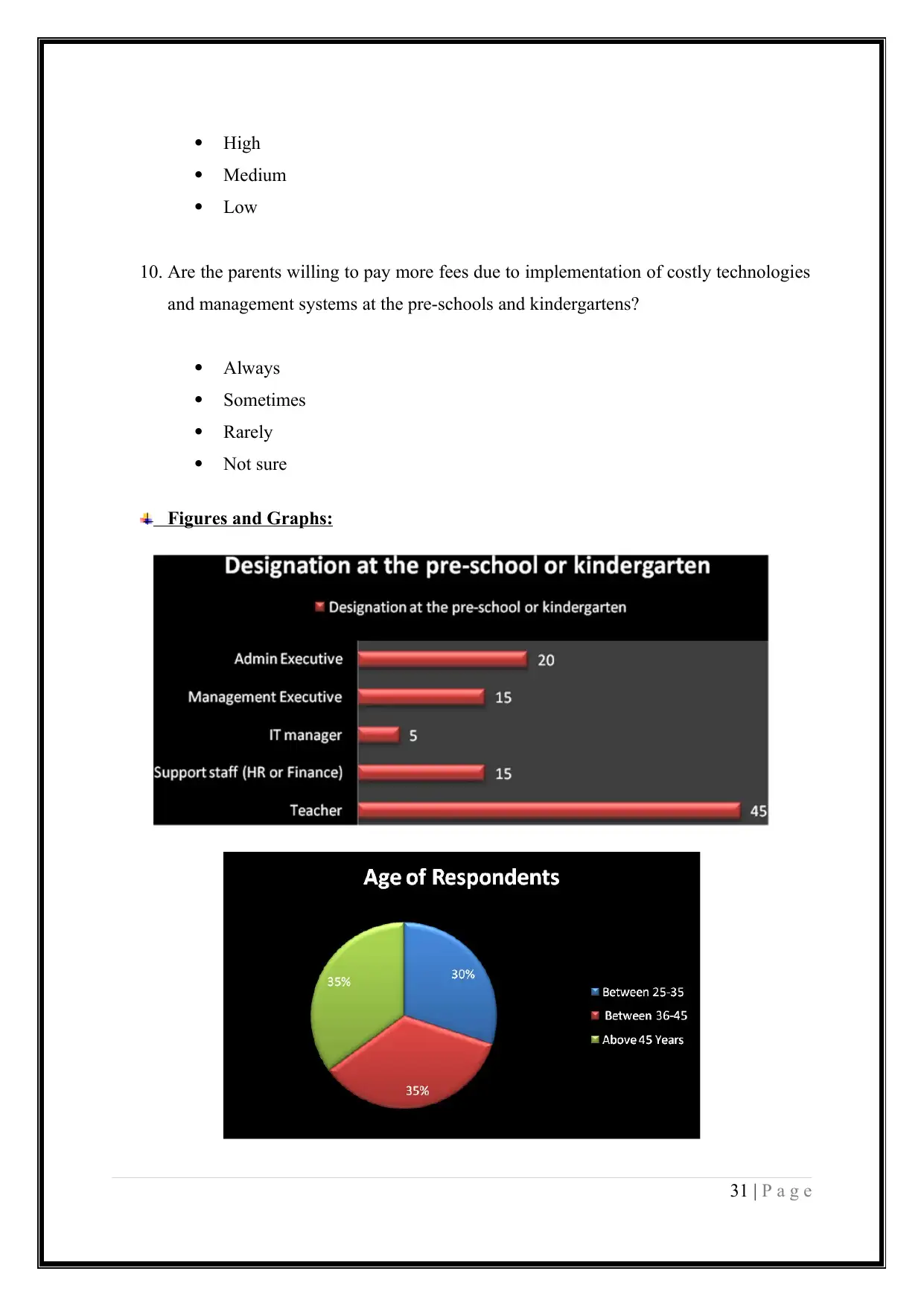
High
Medium
Low
10. Are the parents willing to pay more fees due to implementation of costly technologies
and management systems at the pre-schools and kindergartens?
Always
Sometimes
Rarely
Not sure
Figures and Graphs:
31 | P a g e
Medium
Low
10. Are the parents willing to pay more fees due to implementation of costly technologies
and management systems at the pre-schools and kindergartens?
Always
Sometimes
Rarely
Not sure
Figures and Graphs:
31 | P a g e
1 out of 31
Related Documents
Your All-in-One AI-Powered Toolkit for Academic Success.
+13062052269
info@desklib.com
Available 24*7 on WhatsApp / Email
![[object Object]](/_next/static/media/star-bottom.7253800d.svg)
Unlock your academic potential
© 2024 | Zucol Services PVT LTD | All rights reserved.





